- Homeschooling
- World Culture
- How to Work at Home With Kids
- Managing Screen Time
- Mindful Parenting
- The Secret of Joyful Parenting
- Crochet Doll Pattern
- DIY Cardboard Crafts
- Pour Painting
- Sewing Tutorials
- Calm Down Activities
- Picture Book Activities
- Outdoor Game Day Ideas
- Play Dough Recipe
- Family Road Trip
- Tips for Long Flights With Kids
- Packing for Trips With Children
- Why Go On a Family Road Trip
- Gift Guides

Simple Experiments for Kids: Plants and sunlight
Did you know that plants crave sunlight so much that they will bend to follow it? Kids love this simple visual phototropism plant science experiment , and it’s one of our favorite simple experiments for kids.
Some links on this site are affiliate links and I may earn a small commission at no cost to you. Thank you! Learn more .
Our summer gardening experiment led to several questions about plants. I explained that plants get energy from the sun, and designed this simple experiment to teach my kids how important the sun is to plants. It’s the perfect companion to this week’s Virtual Book Club pick, The Tiny Seed .
What You'll Find on This Page
For this phototropism experiment, we put a tomato seedling in front of a window, and observed that it bent its stem to expose its leaves completely to the sun. We marked which side of the pot the leaves were leaning using a marker. You’ll find an example of this on the right edge of the pot in the photo above. Then we rotated the pot so that the plant was facing away. We did this several times, always marking the edge of the pot that the leaves were closest to. The kids were amazed to find that the plant changed directions to get as much sunlight as possible.
While the photos in this post are from when my kids were very small, it’s an experiment we’ve repeated over the years, explaining what is going on in greater complexity as they grow older.
How to Adapt This Simple Experiment for older kids:
- Ask them to predict what, if anything, will happen to the plant after it is moved in front of the window
- Once the plant moves, ask them to explain why.
Plant Science Picture Books to Read
There are also some great picture books you can read to go along with this experiment, for example:
- Roots by Vijaya Khisty Bodach
- Seed to Plant by Kristin Baird Rattini
- How a Seed Grows by Helene J. Jordan
- From Seed to Plant by Gail Gibbons
Do you have a favorite plant science picture book that I should I add to my list?
The experiment definitely made an impression on then-four-year-old Emma. She spent weeks afterwards drawing plants in the sun, like this:
The little animal on the top right is a bumblebee, pollinating the flowers =)
More Plant Themed Learning Activities for Kids
Extend this simple science experiment with more plant themed learning:
- A simple plant biology exploration .
- Grow grass – and enjoy trimming it (in small quantities!).
- Learn why fruits and vegetables get soft when cooked .
- Explore gardening fun for kids .
- Practice counting with this plant themed coding worksheet for preschoolers .
- Develop math skills with a flower patterning activity .
- Make your own hanging painted flower craft .
- Learn letters by spraying an alphabet garden .
- Make a plant journal .
More Gardening Ideas for Families
Gardening activities for families to enjoy together.
Garden Book Activities for Children Everywhere
Here are some of our favorite gardening activities for kids to go along with one of my favorite pictures books, The Curious Garden .
How to Plant a Container Garden with Kids
Tips for planting a container garden – what type of garden to set up, and plants you might want to try when working with kids.
6 Surprising Health Benefits of Growing Plants
Gardens are beautiful. They are healthy too, including in ways you might not expect. Discover the benefits of growing plants .
Tips for Using Recycled Materials in the Garden - Upcycled Gardening
Combine green recycling with green gardening through these fun ideas for using recycled materials in the garden .
Plant Biology for Kids & Garden Themed Learning Activities
A simple introduction to plant biology for kids , plus more garden-themed learning activities that pair beautifully with picture books listed in the post.
Gardening Fun for Kids
Simple ways to garden with your kids from spring through summer.
Gardening With Kids: Tips for Planting Tomatoes
Tips for planting tomatoes with kids, especially in climates where you can get surprise cold snaps in spring.
Tips for Gardening With Kids
Helpful tips for gardening with kids, plus more gardening activities for kids. These ideas work with all ages and gardens of all sizes!
Shamrock Gardens: Fun Ways to Create and Grow Clover
Clover is easy and fun to grow!
Growing Grass and Other Earth Day Learning Activities for Preschoolers
Grass is easy and fun to grow, making it the perfect preschooler science activity. This post also features other Earth Day themed learning activities for preschoolers.
What are your favorite simple experiments for kids? Do you have another plant themed learning activity to share? Share your recommendations on my Facebook page , or tag me on Instagram .
MaryAnne Kochenderfer
MaryAnne is a craft loving educator, musician, photographer, and writer who lives in Silicon Valley with her husband Mike and their four children.
Do Plants Need Sunlight?
This lesson developed by reach out.
Recommended Age Group: Early Elementary, Later Elementary
Guiding Questions:
1. Do plants need sunlight?
2. What happens if plants do not get sunlight?
Plants need sunlight (or the right kind and amount of electric light) in order to make chlorophyll .
Chlorophyll is the chemical that makes plants green.
Principles:
Green plants need these things in order to use the energy from light in order to grow:
If plants do not get sunlight, they cannot produce chlorophyll and they will lose their green color and eventually die.
If plants lack any of the other things they need to grow, they will die.
Note that some plants are not green, although they do have chlorophyll. In colorful plants like coleus or purpleleaf plum, the chlorophyll’s color is masked or hidden by other pigments.
Preparation
Room Preparation: Need to be able to put plants on a shelf or table where they get plenty of sunlight.
Safety Precautions: None
Procedures and Activity
Introduction.
Ask the guiding questions:
Ask children to share ideas, facts or experiences to answer the first question, “Do plants need sunlight?” Don’t accept a simple “yes” or “no.”
Children will probably agree that plants need sunlight or they will die. Then deal with the second question, “What happens if plants do not get sunlight?” Share that in order for us to answer this question, we need to think and act like scientists. A scientist takes a question like this and then conducts an experiment to see what really happens and to gather data or facts.
Today, we will start an experiment that will take a week to conduct, to see if plants need sunlight and to see what happens to plants when they don’t get sunlight.
Give each pair or small group of 3—4 students a plant. Have them cut out of the black construction paper 4 square or oval pieces. Cover up 2 leaves on the healthy green plant with the black construction paper pieces, one on top of the leaf and one piece on the bottom of the leaf. Secure the papers on the leaf with paper clips.
Have students look at their leaves to make sure that the entire leaf area on top and on the bottom is covered up and won’t be able to get any sunlight.
After a week, remove the paper clips and pieces of black construction paper. What do the leaves look like? What color are they? What do you think happened?
Leave the plants on the windowsill or table top for another week. Water the plants when needed. Watch the leaves and see what happens to them when they are able to get sunlight again. What causes them to turn green again?
Closing - Original Question
Ask again:
Listen as children discuss their experiment, what they observed, and draw conclusions on what they think happened to leaves when they were covered up and then uncovered. Encourage them to use terms including sunlight, energy, chlorophyll, and experiment.
If possible, let them help another group conduct this experiment. You can really see if they understand the concepts when they teach someone else!
Extension Ideas
An alert reader has noted that this lesson is over-simplified for children. Note that “This is not a conclusive experiment to show that plants require light. Covering the bottom of the leaf may prevent carbon dioxide from entering the leaf stomata, which will prevent photosynthesis even with adequate light.” Putting the entire plant in a dark closet would be a more definitive experiment.
Some may be interested in learning more about chlorophyll and photosynthesis. Encourage them to do some research and gather information to share with others. The article “ Avoid Misconceptions when Teaching about Plants ,” by the reader referred to above, is a detailed and comprehensive source.
Another fun and easy experiment is to take a shoe box or other cardboard box cover and put it on top of a very green grassy area. Put a rock on top of the box so it stays put. Every day for a week, take a quick peek to see what is happening to the grass under the box. After a week, look at the grass and see if there are similarities between it and the leaves we experimented with. Watch the grass for another week to see if it turns green again and how quickly it happens.
Careers Related to Lesson Topic
Prerequisite vocabulary.
| has distilled our best mentor training into a book, . Let us help you answer the important questions determining whether you will enjoy your life's journey! | ||
| Home |
Suggestions or feedback?
MIT News | Massachusetts Institute of Technology
- Machine learning
- Sustainability
- Black holes
- Classes and programs
Departments
- Aeronautics and Astronautics
- Brain and Cognitive Sciences
- Architecture
- Political Science
- Mechanical Engineering
Centers, Labs, & Programs
- Abdul Latif Jameel Poverty Action Lab (J-PAL)
- Picower Institute for Learning and Memory
- Lincoln Laboratory
- School of Architecture + Planning
- School of Engineering
- School of Humanities, Arts, and Social Sciences
- Sloan School of Management
- School of Science
- MIT Schwarzman College of Computing
Understanding how plants use sunlight
Press contact :.
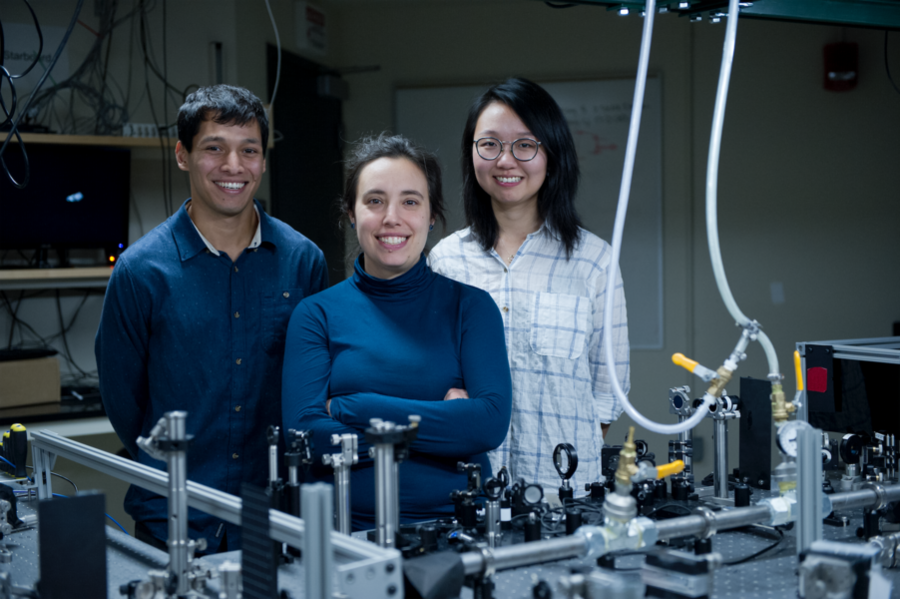
Previous image Next image
Plants rely on the energy in sunlight to produce the nutrients they need. But sometimes they absorb more energy than they can use, and that excess can damage critical proteins. To protect themselves, they convert the excess energy into heat and send it back out. Under some conditions, they may reject as much as 70 percent of all the solar energy they absorb.
“If plants didn’t waste so much of the sun’s energy unnecessarily, they could be producing more biomass,” says Gabriela S. Schlau-Cohen , the Cabot Career Development Assistant Professor of Chemistry. Indeed, scientists estimate that algae could grow as much as 30 percent more material for use as biofuel. More importantly, the world could increase crop yields — a change needed to prevent the significant shortfall between agricultural output and demand for food expected by 2050.
The challenge has been to figure out exactly how the photoprotection system in plants works at the molecular level, in the first 250 picoseconds of the photosynthesis process. (A picosecond is a trillionth of a second.)
“If we could understand how absorbed energy is converted to heat, we might be able to rewire that process to optimize the overall production of biomass and crops,” says Schlau-Cohen. “We could control that switch to make plants less hesitant to shut off the protection. They could still be protected to some extent, and even if a few individuals died, there’d be an increase in the productivity of the remaining population.”
First steps of photosynthesis
Critical to the first steps of photosynthesis are proteins called light-harvesting complexes, or LHCs. When sunlight strikes a leaf, each photon (particle of light) delivers energy that excites an LHC. That excitation passes from one LHC to another until it reaches a so-called reaction center, where it drives chemical reactions that split water into oxygen gas, which is released, and positively charged particles called protons, which remain. The protons activate the production of an enzyme that drives the formation of energy-rich carbohydrates needed to fuel the plant’s metabolism.
But in bright sunlight, protons may form more quickly than the enzyme can use them, and the accumulating protons signal that excess energy is being absorbed and may damage critical components of the plant’s molecular machinery. So some plants have a special type of LHC — called a light-harvesting complex stress-related, or LHCSR — whose job is to intervene. If proton buildup indicates that too much sunlight is being harvested, the LHCSR flips the switch, and some of the energy is dissipated as heat.
It’s a highly effective form of sunscreen for plants — but the LHCSR is reluctant to switch off that quenching setting. When the sun is shining brightly, the LHCSR has quenching turned on. When a passing cloud or flock of birds blocks the sun, it could switch it off and soak up all the available sunlight. But instead, the LHCSR leaves it on — just in case the sun suddenly comes back. As a result, plants reject a lot of energy that they could be using to build more plant material.
An evolutionary success
Much research has focused on the quenching mechanism that regulates the flow of energy within a leaf to prevent damage. Optimized by 3.5 billion years of evolution, its capabilities are impressive. First, it can deal with wildly varying energy inputs. In a single day, the sun’s intensity can increase and decrease by a factor of 100 or even 1,000. And it can react to changes that occur slowly over time — say, at sunrise — and those that happen in just seconds, for example, due to a passing cloud.
Researchers agree that one key to quenching is a pigment within the LHCSR — called a carotenoid — that can take two forms: violaxanthin (Vio) and zeaxanthin (Zea). They’ve observed that LHCSR samples are dominated by Vio molecules under low-light conditions and Zea molecules under high-light conditions. Conversion from Vio to Zea would change various electronic properties of the carotenoids, which could explain the activation of quenching. However, it doesn’t happen quickly enough to respond to a passing cloud. That type of fast change could be a direct response to the buildup of protons, which causes a difference in pH from one region of the LHCSR to another.
Clarifying those photoprotection mechanisms experimentally has proved difficult. Examining the behavior of samples containing thousands of proteins doesn’t provide insights into the molecular-level behavior because various quenching mechanisms occur simultaneously and on different time scales — and in some cases, so quickly that they’re difficult or impossible to observe experimentally.
Testing the behavior of proteins one at a time
Schlau-Cohen and her MIT chemistry colleagues, postdoc Toru Kondo and graduate student Wei Jia Chen, decided to take another tack. Focusing on the LHCSR found in green algae and moss, they examined what was different about the way that stress-related proteins rich in Vio and those rich in Zea respond to light — and they did it one protein at a time.
According to Schlau-Cohen, their approach was made possible by the work of her collaborator Roberto Bassi and his colleagues Alberta Pinnola and Luca Dall’Osto at the University of Verona, in Italy. In earlier research, they had figured out how to purify the individual proteins known to play key roles in quenching. They thus were able to provide samples of individual LHCSRs, some enriched with Vio carotenoids and some with Zea carotenoids.
To test the response to light exposure, Schlau-Cohen’s team uses a laser to shine picosecond light pulses onto a single LHCSR. Using a highly sensitive microscope, they can then detect the fluorescence emitted in response. If the LHCSR is in quench-on mode, it will turn much of the incoming energy into heat and expel it. Little or no energy will be left to be reemitted as fluorescence. But if the LHCSR is in quench-off mode, all of the incoming light will come out as fluorescence.
“So we’re not measuring the quenching directly,” says Schlau-Cohen. “We’re using decreases in fluorescence as a signature of quenching. As the fluorescence goes down, the quenching goes up.”
Using that technique, the MIT researchers examined the two proposed quenching mechanisms: the conversion of Vio to Zea and a direct response to a high proton concentration.
To address the first mechanism, they characterized the response of the Vio-rich and Zea-rich LHCSRs to the pulsed laser light using two measures: the intensity of the fluorescence (based on how many photons they detect in one millisecond) and its lifetime (based on the arrival time of the individual photons).
Using the measured intensities and lifetimes of responses from hundreds of individual LHCSR proteins, they generated the probability distributions shown in the figure above. In each case, the red region shows the most likely outcome based on results from all the single-molecule tests. Outcomes in the yellow region are less likely, and those in the green region are least likely.
The left figure shows the likelihood of intensity-lifetime combinations in the Vio samples, representing the behavior of the quench-off response. Moving to the Zea results in the middle figure, the population shifts to a shorter lifetime and also to a much lower-intensity state — an outcome consistent with Zea being the quench-on state.
To explore the impact of proton concentration, the researchers changed the pH of their system. The results just described came from individual proteins suspended in a solution with a pH of 7.5. In parallel tests, the researchers suspended the proteins in an acidic solution of pH 5, thus in the presence of abundant protons, replicating conditions that would prevail under bright sunlight.
The right figure shows results from the Vio samples. Shifting from pH 7.5 to pH 5 brings a significant decrease in intensity, as it did with the Zea samples, so quenching is now on. But it brings only a slightly shorter lifetime, not the significantly shorter lifetime observed with Zea.
The dramatic decrease in intensity with the Vio-to-Zea conversion and the lowered pH suggests that both are quenching behaviors. But the different impact on lifetime suggests that the quenching mechanisms are different.
“Because the most likely outcome—the red region—moves in different directions, we know that two distinct quenching processes are involved,” says Schlau-Cohen.
Their investigation brought one more interesting observation. The intensity-lifetime results for Vio and Zea in the two pH environments are consistent when they’re taken at time intervals spanning seconds or even minutes in a given sample. According to Schlau-Cohen, the only explanation for such stability is that the responses are due to differing structures, or conformations, of the protein.
“It was known that both pH and the switch of the carotenoid from violaxanthin to zeaxanthin played a role in quenching,” she says. “But what we saw was that there are two different conformational switches at work.”
Based on their results, Schlau-Cohen proposes that the LHCSR can have three distinct conformations. When sunlight is dim, it assumes a conformation that allows all available energy to come in. If bright sunlight suddenly returns, protons quickly build up and reach a critical concentration at which point the LHCSR switches to a quenching-on conformation — probably a more rigid structure that permits energy to be rejected by some mechanism not yet fully understood. And when light increases slowly, the protons accumulate over time, activating an enzyme that in turn accumulates, in the process causing a carotenoid in the LHCSR to change from Vio to Zea — a change in both composition and structure.
“So the former quenching mechanism works in a few seconds, while the latter works over time scales of minutes to hours,” says Schlau-Cohen. Together, those conformational options explain the remarkable control system that enables plants to regulate energy uptake from a source that’s constantly changing.
Exploring what comes next
Schlau-Cohen is now turning her attention to the next important step in photosynthesis — the rapid transfer of energy through the network of LHCs to the reaction center. The structure of individual LHCs has a major impact on how quickly excitation energy can jump from one protein to the next. Some investigators are therefore exploring how the LHC structure may be affected by interactions between the protein and the lipid membrane in which it’s suspended.
However, their experiments typically involve sample proteins mixed with detergent, and while detergent is similar to natural lipids in some ways, its impact on proteins can be very different, says Schlau-Cohen. She and her colleagues have therefore developed a new system that suspends single proteins in lipids more like those found in natural membranes. Already, tests using ultrafast spectroscopy on those samples has shown that one key energy-transfer step occurs 30 percent faster than measured in detergents. Those results support the value of the new technique in exploring photosynthesis and demonstrate the importance of using near-native lipid environments in such studies.
Research on the heat-dissipation mechanism was supported by the Center for Excitonics, an Energy Frontier Research Center funded by the US Department of Energy; a CIFAR Azrieli Global Scholar Award; and the European Economic Community projects AccliPhot and SE2B. Research on energy transfer was supported by the US Department of Energy, Office of Science, Office of Basic Energy, and by the Singapore-MIT Alliance for Research and Technology.
This article appears in the Autumn 2018 issue of Energy Futures , the magazine of the MIT Energy Initiative.
Share this news article on:
Related links.
- Paper: “Single-molecule spectroscopy of LHCSR1 protein dynamics identifies two distinct states responsible for multi-timescale photosynthetic photoprotection”
- Paper: "Impact of the lipid bilayer on energy transfer kinetics in the photosynthetic protein LH2”
- Gabriela Schlau-Cohen
- Energy Futures Magazine
- MIT Energy Initiative
- Department of Chemistry
Related Topics
- Biochemistry
- Spectroscopy
Related Articles
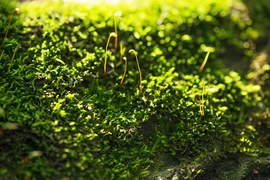
Harnessing the right amount of sunshine
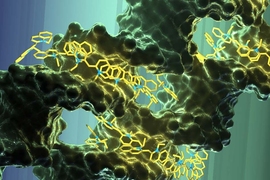
Synthetic circuits can harvest light energy
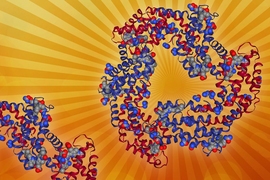
How photosynthetic pigments harvest light
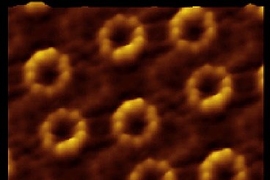
Secret of efficient photosynthesis is decoded
Previous item Next item
More MIT News
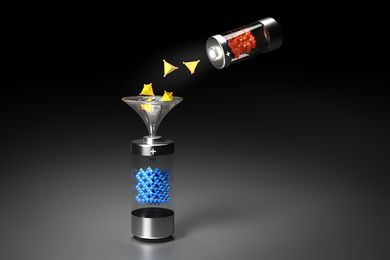
Study of disordered rock salts leads to battery breakthrough
Read full story →

Toward a code-breaking quantum computer

Uphill battles: Across the country in 75 days

3 Questions: From the bench to the battlefield

Duane Boning named vice provost for international activities
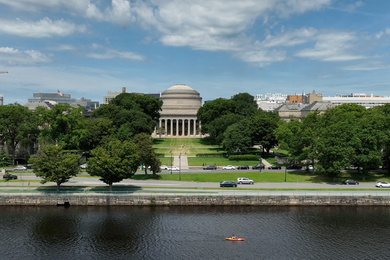
Q&A: Undergraduate admissions in the wake of the 2023 Supreme Court ruling
- More news on MIT News homepage →
Massachusetts Institute of Technology 77 Massachusetts Avenue, Cambridge, MA, USA
- Map (opens in new window)
- Events (opens in new window)
- People (opens in new window)
- Careers (opens in new window)
- Accessibility
- Social Media Hub
- MIT on Facebook
- MIT on YouTube
- MIT on Instagram
- Skip to main content
- Skip to primary sidebar
Second Grade teachers! Join me Around the 2nd Grade Kampfire on Facebook! JOIN HERE
- Facebook Group
- Search this website
Around the Kampfire
Elementary Teaching Blog
Last updated by Linda Kamp on March 15, 2023 • Leave a Comment
Plant Needs Experiment: Can Plants Grow in the Dark?
Try this easy plant needs experiment for students to explore why plants need sunlight.
2 nd Grade Plant Needs Experiment
When we study plants during our plant and animal interdependence unit in 2 nd grade, we spend time learning about plant needs and adaptations. My students are always very curious to know what happens if plants don’t get what they need. This plant needs experiment shows my students the answer to that question, and it also allows them to practice using scientific processes to design and execute experiments.
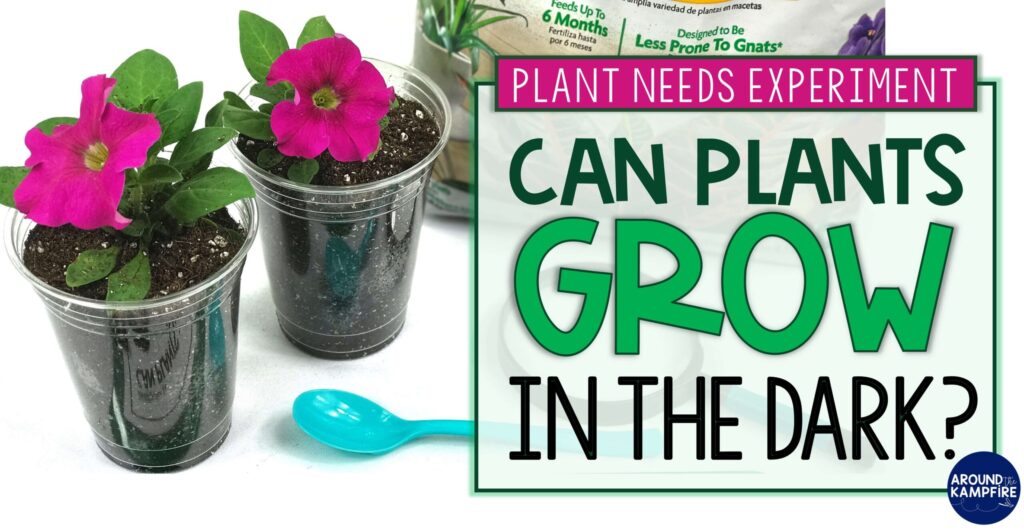
What do plants need to grow?
Plants, like all living things, have basic needs to survive and grow. Plants need sunlight, air, soil, and water. Without these basic needs, plants cannot grow, produce seeds, or continue their life cycle.
Sunlight plays a crucial role in plants’ survival. Plants need energy from the sun to make food through the process of photosynthesis. Photosynthesis is the process within a plant that converts sunlight, oxygen, and water into food. Without sunlight, plants cannot produce their own food.
This plant needs experiment is a great way to demonstrate the importance of plant needs in plants’ survival. In this investigation, students will complete an experiment to determine if plants can grow without sunlight.
Students will make observations over time on two plants. One plant will be left in the sunlight, while the other will be placed in a dark area or covered with a box.
Designing a plant needs experiment
This science lab is a good opportunity for students to practice using the scientific method more independently. Have students work in partners or groups to design their own experiment based on the question: Can plants live in the dark?
Ask students use the question to form a hypothesis and design an experiment to answer it. They write their own procedures to test their hypothesis and they get to determine how often to observe and record data on their plants on their own.
My 2 nd graders absolutely love getting to be in the driver’s seat when it comes to designing this experiment! It really helps them take more ownership in the process, so it’s great for engagement.
When I plan for this activity, I allow for it to be a 2-day “set up” process. On Day 1 I introduce the activity and students design their experiment. On Day 2 students pot their plants and begin their experiment. Then, I plan for several follow up days for students to observe and record data about their plants.
Plant Needs Experiment: Can plants grow in the dark?

- 2 small plants per group
- plastic cups
- potting soil
1. Students work in groups to form a hypothesis and design their experiment based on the question: Can plants live in the dark? They record the hypothesis and plan on their lab sheets.
2. Distribute materials for potting the plants to each group of students. Students plant their flowers in cups with soil, then water the plants. In the spring months, the dollar store often has smaller bags of potting soil, which are more manageable and only $1!
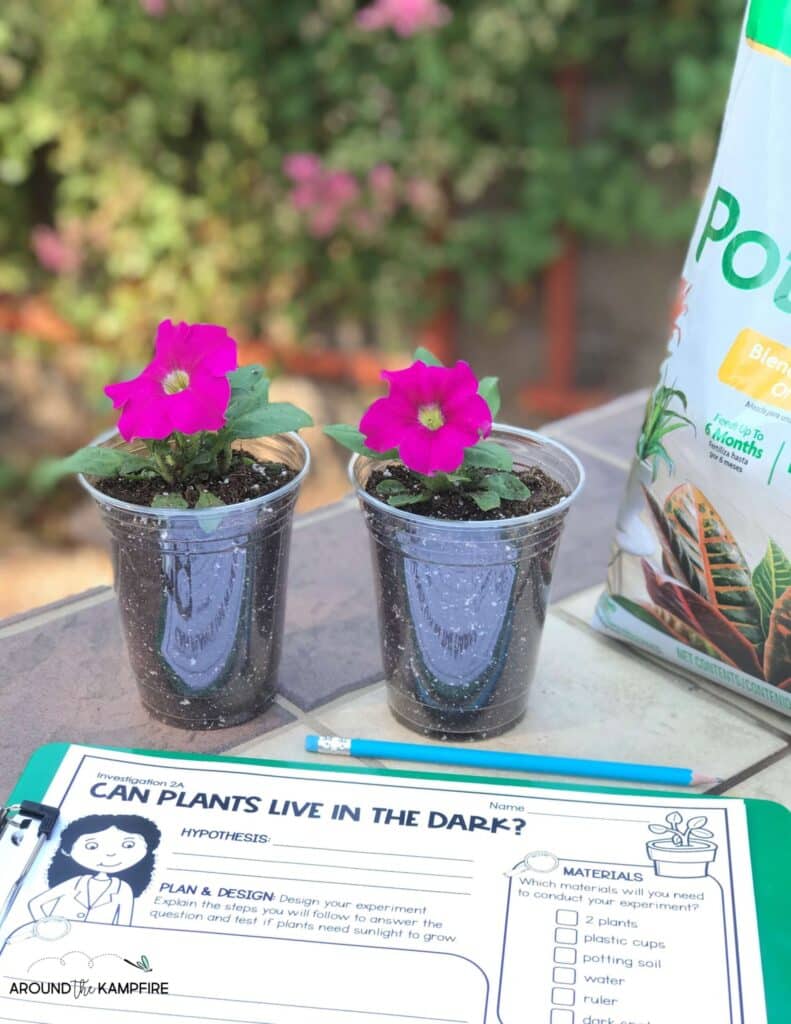
3. Next, students complete Day 1 on their lab sheet by recording the starting data for both plants.
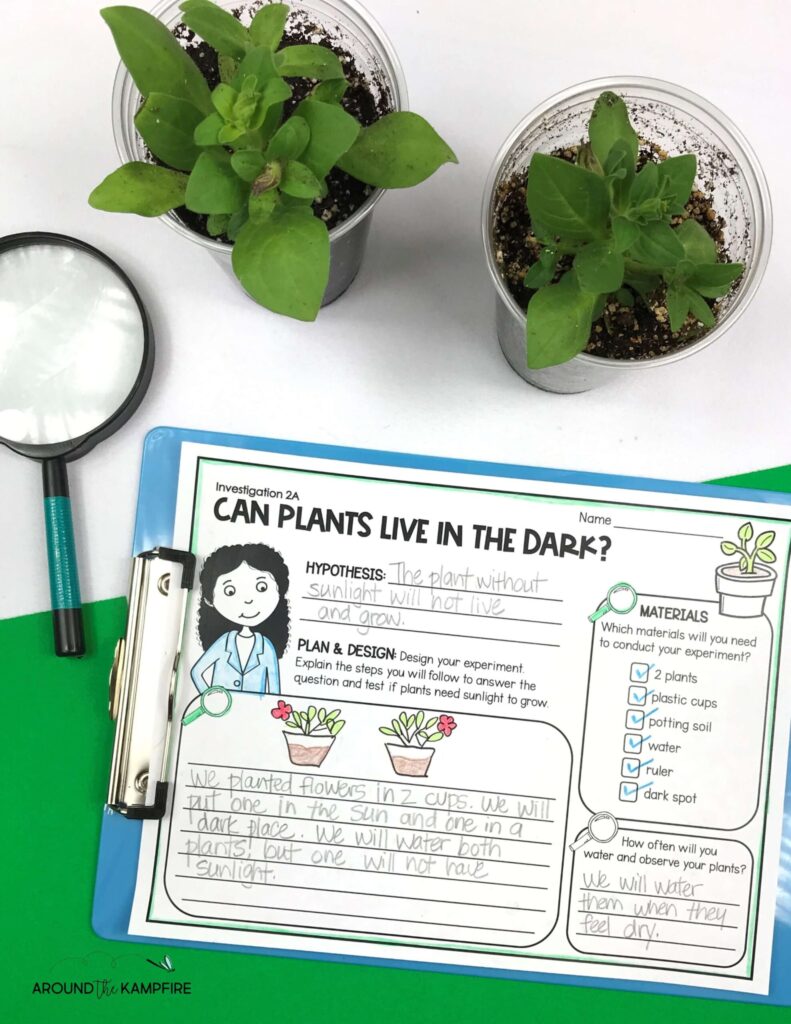
4. Place one plant in a sunny location and one in a cupboard or dark spot without sunlight. Another option is to place a paper bag, box, or anything opaque over the second plant.

5. Students check their plants daily and water them if they are dry. Students record observations every third day or more often if they notice a significant change.
6. After observing and recording data on the plants for a set amount of time, students will analyze the data they have collected to determine the answer to the question.
More plant needs experiments, activities, and lessons
In this plant needs experiment, students are able to see the effects that lack of sunlight has on a plant over time. My students love checking on their plants each day and making observations!
This plant needs experiment is part of a complete NGSS Plants, Animals, & Life Cycles unit for 2 nd grade that is also available in a digital format .
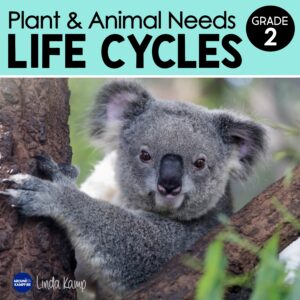
Click for the Plant and Animal Needs science unit.
Click here to see the yearlong 2nd grade science curriculum aligned to NGSS.

Don’t forget to Pin this lab activity so you have it for your plant unit!
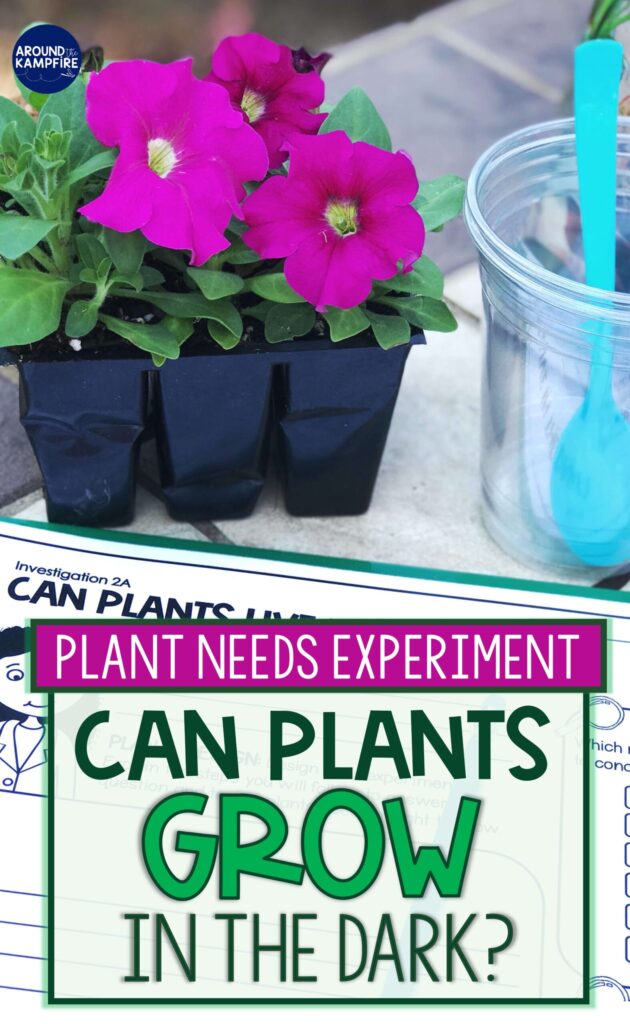
Visit these posts for more plant needs and life cycle science activities:
P l ant Life Cycle Activities & Labs

15 Life Cycle Projects for Spring

Butterfly Life Cycle Activities & Free Printables

Happy teaching!
Share this:

Back to School
Free Grammar Review Activities!
Start the year in grammar off right! Grab a full week of lesson plans, teaching slides, and printables to review and practice parts of speech!

You May Also Enjoy These Posts

Reader Interactions
Leave a comment cancel reply.
Your email address will not be published. Required fields are marked *
Notify me of new posts by email.
Hello Friends
I’m Linda Kamp, a 20 year primary grade teacher with a passion for creating educational materials that excite students and make learning fun! I'm so glad you're here!


Plants Science Experiments & Teaching How Plants Grow
I love doing plant experiments and sprouting seeds with young children in the spring. Not only do they get excited to see how plants grow but planting seeds also teaches them patience and how to wait for gratification which is very important in this fast-paced, instant gratification world in which we now live. In this post I’m sharing some of my favorites from over the years.
What Liquid is Best for Growing Seeds? Experiment
This experiment tests what type of liquid is best for growing seeds and can be done using a wide variety of liquids. Since we already discussed that plants need water to grow, we first tested different types of water to see if it made a difference. We decided to test tap water, bottled water, sugar water (1 cup of water with 1 Tbsp sugar), and salt water (1 cup water with 1 Tbsp salt). I used grass seed for this experiment because it sprouts fairly quickly but you can use bean seeds (lima beans soaked overnight in water work well) or any other type of seed you wish.
We added the same amount of soil and seed to each cup and labeled them. We then measured out the same amount of water for each cup and watered the seeds with the different types of water and set them by the window. Students make predictions as to which one they feel will work best.

We observed the seeds for 5 days and were a little surprised that the bottled water didn’t grow as well as the tap water. The tap water grew the best, followed by the bottled water, the sugar water had a few blades come up, and the salt water did not have any.

When looking at the label of the bottled water we found that additional ingredients are added (calcium chloride, sodium bicarbonate, and magnesium sulfate) which most likely lead to mineral imbalances in the soil that slowed growth. Liquids with very high sugar or salt levels can actually pull water away from the plant or seed rather than allowing the water to be absorbed. In conclusion, simple pure tap water worked best.
We then do the experiment with liquids other than water to see if another type of liquid could be used if water isn’t available. You can use any liquids you have on hand, just make sure that one of them is water to use as the comparison. We have tried vinegar, oil, rubbing alcohol, lemon juice. As expected, water always works best. Last year students had the idea to test liquids that we drink to see if plants would drink them too. I thought this was very creative! We tested vitamin water, pop (soda), and juice.
We added the same amount of soil and seed to each cup and labeled them. We then measured out the same amount of liquid for each cup and watered the seeds with the different types of liquids and set them by the window. Students made predictions as to which liquid they feel would work best.

We observed them for a week. Our results were that water was best, followed by the vitamin water. Neither the juice or pop had any sprouts.

Using liquids that are very acidic or very alkaline lead to mineral imbalances in the soil that will kill plants or slow growth. Liquids with very high sugar or salt levels can actually pull water away from the plant or seed rather than allowing the water to be absorbed.
I have students record their results.

How Plants Drink Science Experiment
This experiment has been around for years and is a great way to demonstrate to students how plants get water from their roots all the way up to their leaves.
It is very simple to set up. Celery stalks that have leaves at the top work best. The stalks on the inside of the bundle of celery usually have the most leaves.
Cut about an inch or so off the bottom of the celery stalks.
Fill each container about halfway with water and drop 10-15 drops of food coloring in each glass. Place the celery stalks in the water.

I also like to do a split stalk one. Cut one stalk in half part way up and place one half in one color and the other in a different color.

Observe the celery at the end of the school day. You may see a little color in the stalk or the leaves. Observe them again the next day and you should see color in the leaves. After 48 hours you will really notice changes and color in the stalks and leaves showing that the water traveled up through the stalk to the leaves.

The split celery stalk should show the separate colors on each side and then a mix of the colors in the leaves in the middle. In the pictures below the blue is on the left, red on the right, and some purple leaves in the center.

You can cut open the stalks to allow students to see the small tubes inside the stalks that carried up the colored water to the leaves.

After cutting open the celery we discuss the results. I introduce some bigger vocabulary to them when we talk about the science behind the experiment, but I basically just want them to understand that the water travels up the stem through tiny tubes to the leaves. Here is a simple explanation:
The Science Behind It:
This experiment demonstrates how plants use capillary action to draw water up their stems. Capillary action is the process in which a liquid, like water, moves up something solid, like the tubes (xylem) in the stem. The leaves help pull the water up the xylem through transpiration. The leaves have little holes that let out the water that the plant is done using. This makes room for more water to come rushing up through the stem.
I have students record their observations by coloring the celery on their recording page (I created pages with the celery already drawn to make it easier for my young students). Then they write what they learned along the bottom.

Do Plants Need Light? Experiment
This experiment tests whether plants need light to grow. You can choose to plant 2 containers of seeds and set one in direct sunlight near a window and one in complete darkness OR plant 3 containers and set one in complete sunlight near a window, one in partial light, and one in complete darkness (it is important that there is NO light).
Plant the same number of seeds in each container with the same amount of soil and label each container.
Have students help you decide the best places in the room to place each container (by a sunny window, in a closet that gets NO light, in a file cabinet drawer, on a shelf in partial light, inside a closed box, etc.)
Observe the containers for about 2 weeks (or however long it takes to see growth) watering as needed. At the end of the experiment, put the containers side by side and discuss the results.
We do 3 containers – one by the window in full sunlight, one on a shelf that gets partial light, and one in the back of the closet behind a box.
The one near the window shows the most growth, the one in the partial light has growth on the side of the container that received partial light and grows towards the light, the container in total darkness has no growth.

Plants need light to grow because it is an important part of photosynthesis, the process plants use to convert carbon dioxide and water into food. Without light, photosynthesis does not work properly and therefore the plant does not get enough food. However, not all plants need the same amount of sunlight. There are types of plants that need a lot of bright sunshine and some that can survive with only a little light, but in the absence of ALL light plants will not survive. If you had a seed sprout in the dark, it may have used energy stored up in the seed to begin growing but it will not continue to grow without light.
I have students record their results on recording pages.

Growing Grass Science Activity
Growing grass is a great activity to do with young children because it is easy to plant and grows fairly quickly. It also teaches them about the needs of plants and develops patience because they have to wait for the results and observe changes over time.
A fun option that I like to do is put faces on the cups or containers and have the grass be the face’s hair. You can glue on actual photos of the students’ faces or have them draw faces on the cup or use accessories such as wiggle eyes. You can also do this activity around St. Patrick’s Day and put leprechaun faces on the containers and grow green leprechaun “hair”.

I have students use plastic spoons to fill their cups about ¾ full with dirt/soil. Then have them sprinkle grass seed on top of the dirt. There is no need to measure out the seed, however I usually tell students to cover the dirt with seed (the more seed, the more grass that will grow). Then have them cover the seeds with a small amount of dirt.
Lastly, I have students water their seeds with a spray bottle. I like using a spray bottle because it prevents over watering (and then once the grass “hair” starts to grow, students pretend the water is hairspray lol).

I have students help determine the best location in the room for their grass seed (next to a sunny window) and guess how many days they think it will take for their grass to grow.
We usually see some type of growth by day 3 or so.

Once it sprouts the grass grows fairly quickly.

I’ve done several different activities with students. One is having them predict how long they think it will take their grass to grow and then recording the actual results.

We practice measurement skills by measuring how tall the grass has grown.

After students’ grass hair grows, I let cut their hair with scissors and then estimate how long they think it will be until it grows back.

Growing Bean Sprouts
This is another experiment that has been around for years but is a wonderful way for students to observe beans sprouting and see what happens underground when a seed is planted.
I have done this experiment 3 different ways.
Growing Beans in a Jar
This is a good method to use if you want to do a class experiment and you do NOT want each student to grow their own seeds.
Stuff a large jar with paper towels. Students can help.

Slowly pour some water in the jar to wet the paper towels but do not flood it. If you have any excess water at the bottom pour it out. You want the paper towels to be damp not soaking wet.
Push your seeds down in between the jar and paper towels and make sure they are firmly in place (a snug fit between the jar and towels).
Place several seeds around each side of the jar. Place the jar near a sunny window.

Check on the jar daily. You should see a root come out of the seed first within 3 days. If you used bean seeds you should be able to observe the plant until it grows to the top of the jar.

I like having students keep plant journals because they improve their observation and recording skills and give them a record of the seed’s growth. Students do a recording page for each observation.

Sprouting Beans in Baggies on a Sunny Window
This method requires a bright sunny window on which you can hang baggies that contain the seeds. You are making a plastic baggie “greenhouse” for the seeds. You can choose to have each student plant their own beans in their own baggie or plant a few baggies as a class. If you choose to have students do their own seeds and baggies, it’s a good idea to plant extra seeds in case some students’ seeds do not grow. If this happens, switch out the seeds when students are not there to ensure that each child has at least one bean that sprouts.
If doing individual bags for each student, have students write their name on their baggie with a marker. Optional: you can also have them write the date. If doing a class experiment, you can write the date on the baggies.
For each baggie, place a dampened, folded paper towel along the bottom. It should have a fair amount of water but not be soaking or dripping wet.

Place one or several bean seeds between the paper towel and the baggie.

Tape or Sticky Tac them on a bright, sunny window.
Check them daily. You should see a root come out of the seed first within 3 days.

I have students keep plant journals similar to the one shown above but the recording pages are slightly different. I have the baggie already drawn for them to make it easier. Students can also upload real photos to Pic Collage and complete their journals using the app.

Growing Seeds in a Greenhouse on a Window
This method is the same as the baggie method shown above except students make a greenhouse from construction paper and place their baggie in the opening.

Hang them on a sunny window and make daily observations.

The journal pages I use for this method have the greenhouse already drawn to make it easier for students to record results.

We take the bean plants that have grown to the top of the jar or baggies and carefully put them in soil. I explain to students that the plant needs the support and nutrients from soil to continue to grow larger.

What Do Plants Need to Grow? Pages
I like using these pages to check individual student understanding of what plants need to grow. On the first page they have to circle the correct pictures. On the second page they unscramble the words and write the correct words on the lines.

If you would like to use the printables, activities, word wall cards, label cards, play dough recipe, and more with your students they are available in my Plants & Flowers Science Activities resource . It also includes experiments for plants & seeds, step by step directions with photos for easy set-up, plant journal pages, and more. Click here to see complete details and photos of each activity.

Have engaging science experiments and STEM activities throughout the entire school year with this money-saving Science & STEM Bundle !

You may also like:
Flower science experiments & parts of a flower activities, water cycle, rain cycle science experiments and craftivity.

Hi! Thanks for stopping by!
I’m Tina and I’ve taught preK and K for 20+ years. I share fun and creative ideas that spark your students’ love for learning.
-Featured Products-

Follow my TpT store to find out about new resources & freebies!
-Affiliate Disclosure-
Some of the Amazon links on Lessons for Little Ones are affiliate links. If you purchase a product after clicking an affiliate link, I receive a small percentage of the sale for referring you, at no extra cost to you. Purchasing through affiliate links is an easy, painless way to help out your favorite bloggers. Thank you so much for your continued support!
© 2023 Lessons for Little Ones by Tina O’Block
Privacy Policy | Designed by Megan Milton
© 2023 Lessons for Little Ones by Tina O’Block
Discover more from Lessons for Little Ones by Tina O'Block
Subscribe now to keep reading and get access to the full archive.
Type your email…
Continue reading
Open-and-go lessons that inspire kids to love science.
Sign up now for tons of free lessons like this one, sign up now for a free trial through june 30, 2025. get tons of lessons.

Could a plant survive without light?

Do you think plants need dirt to grow? How could you find out?
Think about how we found out that seeds need water to grow.
What do you think will happen?

Compare these two tomato plants. The one on the left grew in dirt. The one on the right grew in water, but no dirt.
DISCUSS: Which plant looks healthier? Why?
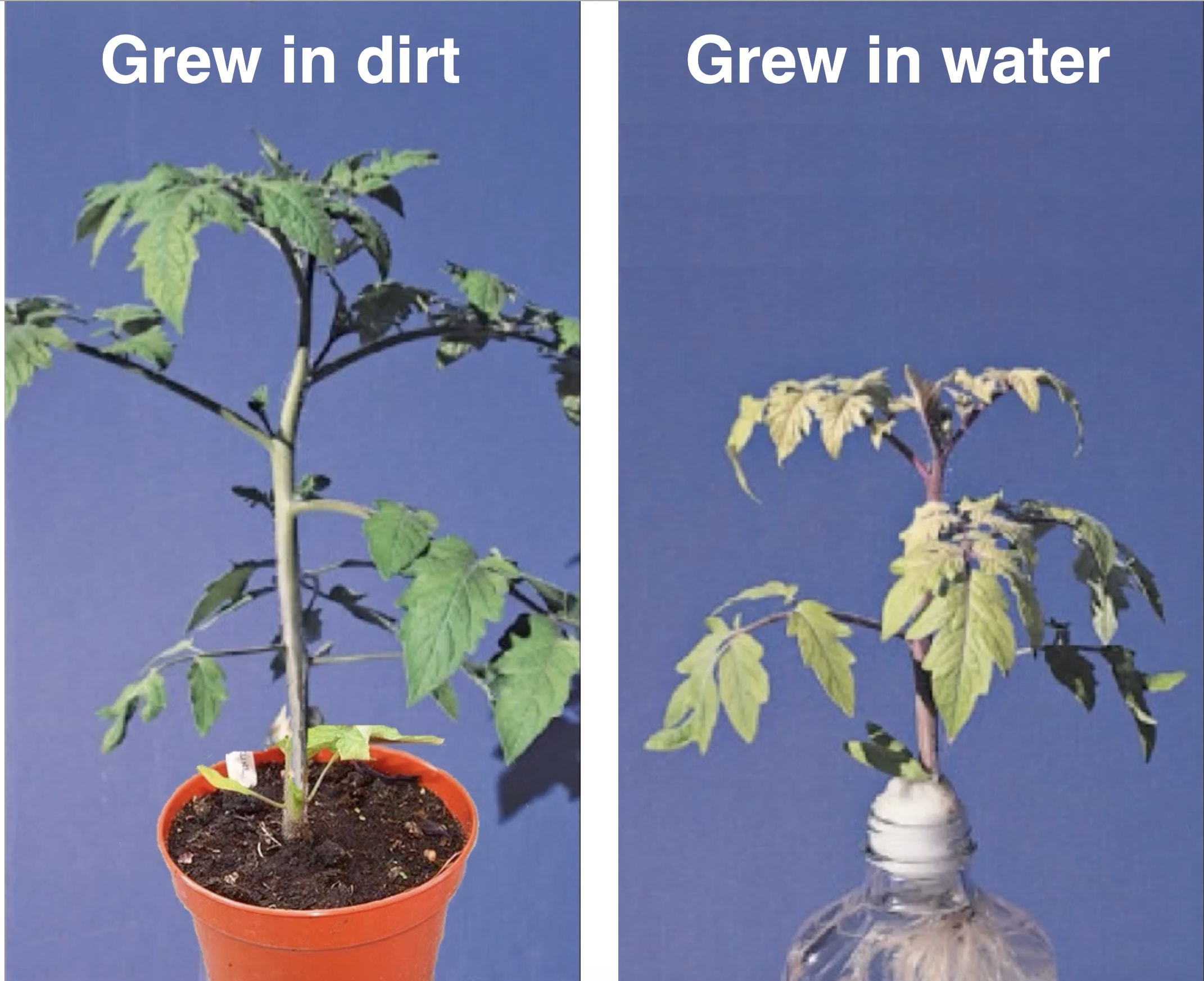
Our experiments show that plants need water and dirt to be healthy. What else do they need?
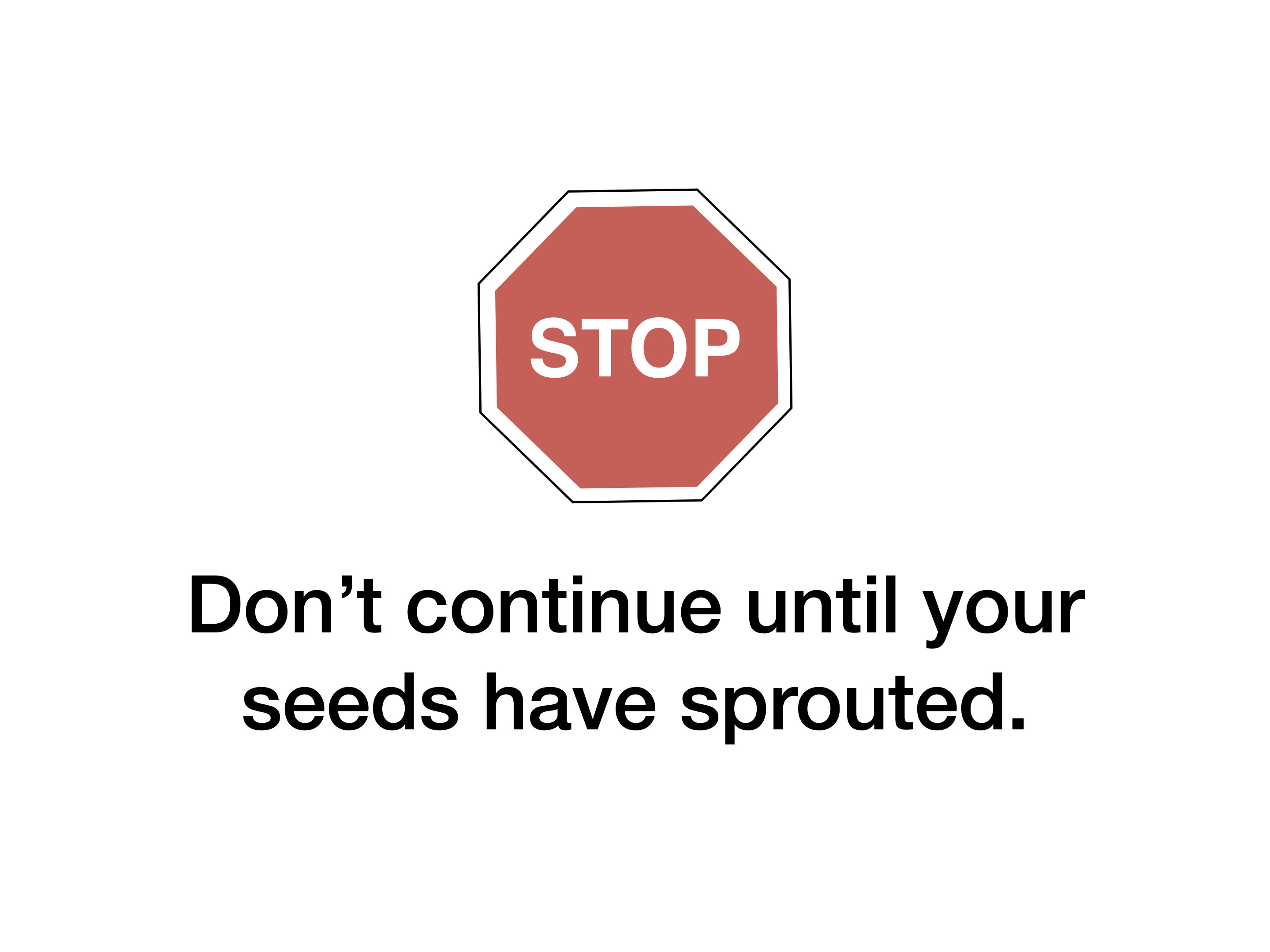
Which plant do you think is healthier: the one that grew in the light or the one that grew in the dark?
Why do you think that?
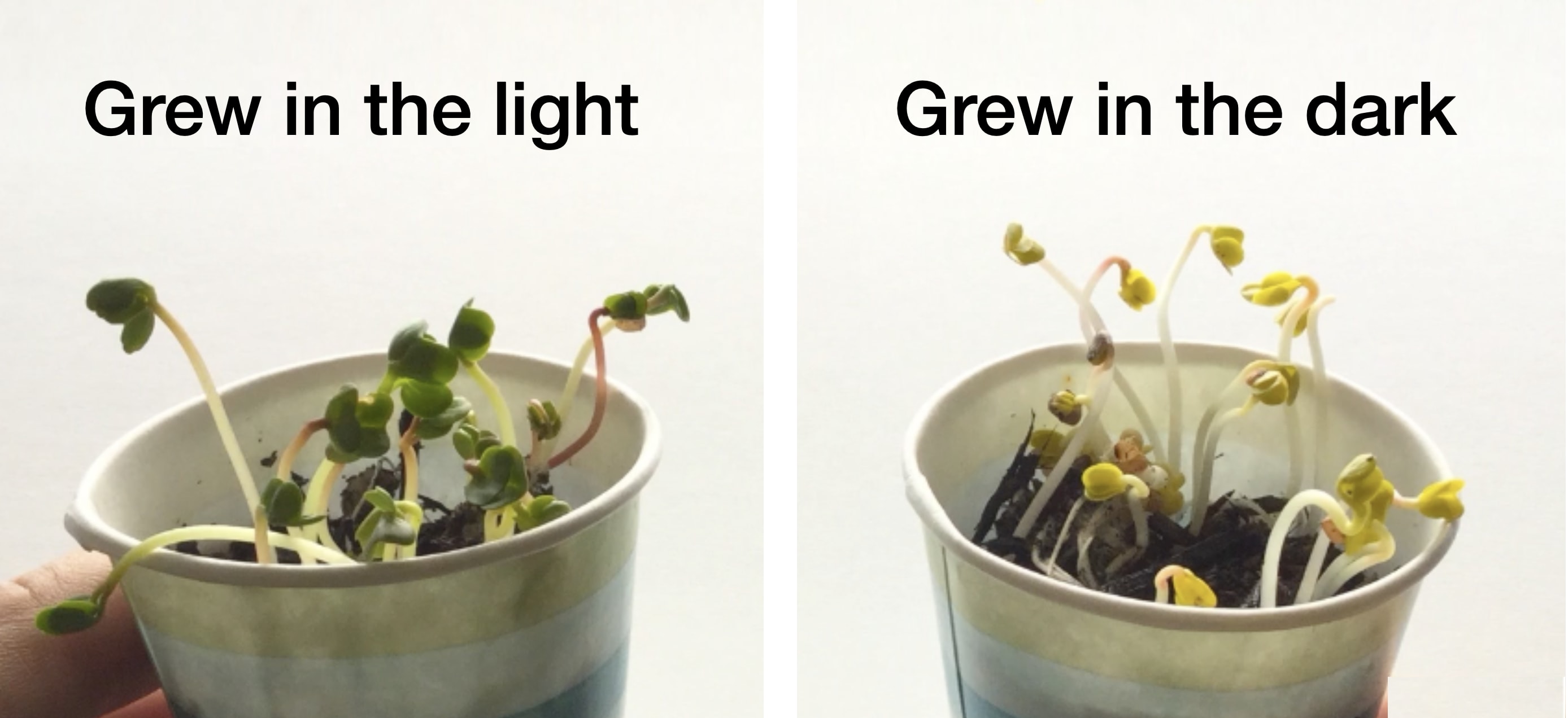
investigate
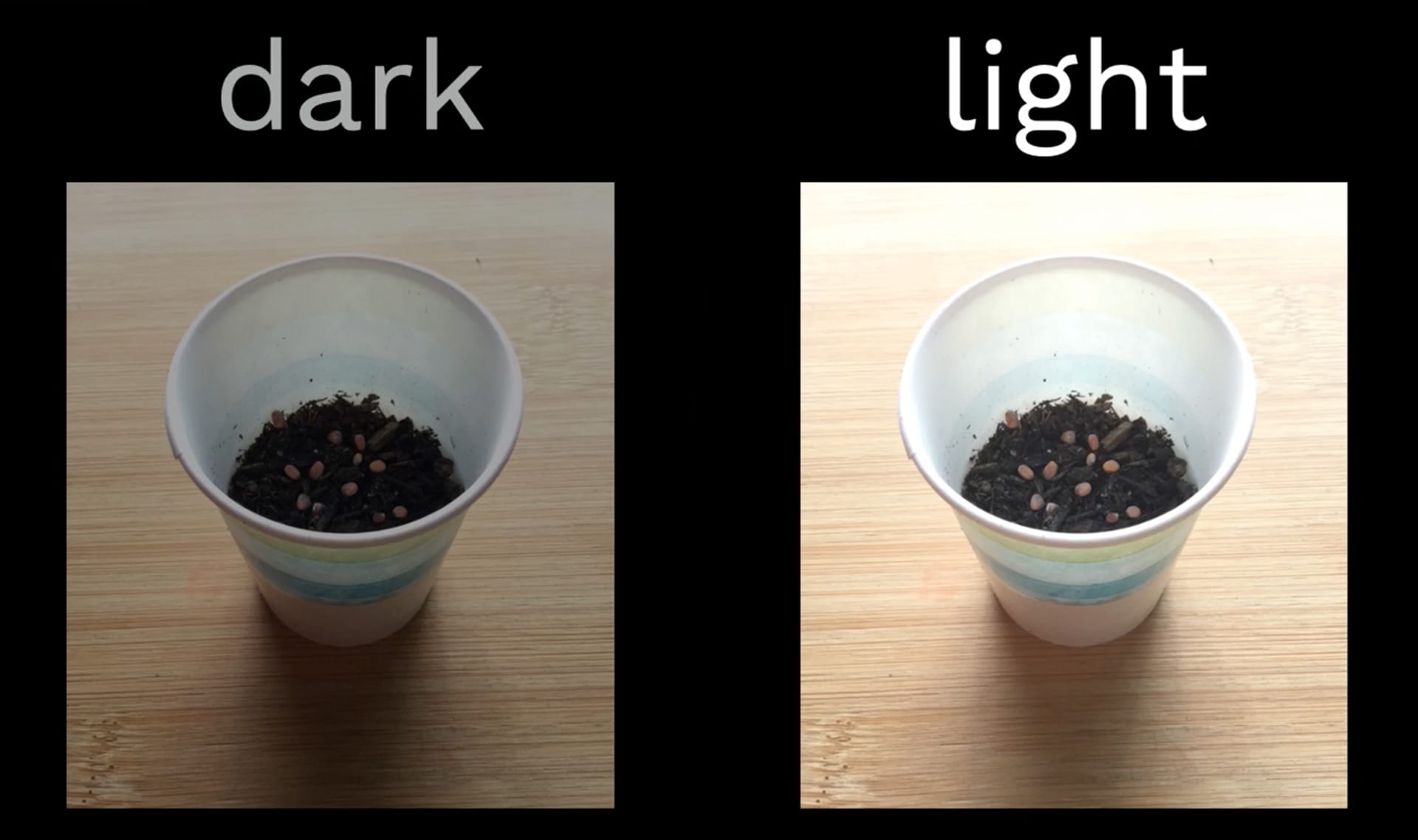
Unit Reading
Assessments, featured reviews.
Plant Adaptations
Water, Sunlight, & Plant Growth
Activity Prep
This lesson was revised on July 24, 2020. Click the following link if you would like to view the previous version . In this lesson, students investigate how plants need water and sunlight to grow. In the two-part activity, Seeds — Light and Dark, students experiment with growing radish seeds in light and dark conditions. They plant them in cups, place half of the cups in sunlight, and put the other half in a dark container. Three to seven days later, students compare the seedlings and then watch what happens when all are placed in sunlight.
I have a Mystery Pack
| worksheet | 30 copies |
| 8 teaspoons | |
| 38 cups | |
| 8 plates | |
| 8 bottles | |
| 30 labels | |
| 1 3-gram packet |
This is a two-part activity. We recommend that you allow at least three days (up to one week) in between Part One and Part Two of the experiment to give the radish seeds time to germinate.
You will need access to a sunny windowsill for radish seeds to grow in the light. You will also need access to water so that you can fill up the spray bottles.
We suggest students work in pairs. Homeschool students can work on their own but will need to prepare at least two Dixie cups so that they can compare what happens to the plants in sunlight versus in the dark.
Prep Radish Seeds
For each group of four students, put about ⅛ teaspoon radish seeds (at least 40 seeds) in a Dixie cup.
Prep Dixie Cups
For each student (or one homeschool student), fill one Dixie cup halfway with moist potting soil. Or if you are using peat pellets, place one pellet in each cup, fill the cup with water, and let the pellet soak up the water for at least 30 minutes.
Prep Spray Bottles
In each spray bottle, mix about 1 cup of water with about ¼ teaspoon of baking soda. Adding baking soda will inhibit mold growth in the soil, but won’t affect the plants.

Plan Your Time
After students complete Part One of this activity, they will need to wait at least three days (up to one week) to give the radish seeds time to germinate. Make sure to spray both the cups in the sunlight and the cups in the dark with water during this time.
When most of the leaves have come up, show Part Two of the activity.
Share this lesson
Student link, google classroom, email parents, extend this lesson, demonstration, transcripts.
How can we improve it?
If you'd like our team to reply to you, please Contact Support instead.
Thanks for your feedback! If you have a question or need help, please contact us . Please consider sharing your review:
Sorry the lesson didn’t go well. We read every single review in an effort to improve our Mysteries.
Thanks for letting us know. We’ll wait to ask you for feedback until after you've actually taught it.
Thanks for the feedback! We read every single review in an effort to improve our Mysteries.
Is the video not playing properly?
- Very rarely a video will fail to completely load in your browser. Try to reload this page to see if that fixes the problem.
- If reloading does not help, try our other video player .
- If the video still fails to play, open this video in a new tab and please let us know you’re having trouble. We want to fix this issue for you.
How can we help you?
This episode is locked.
This lesson is not included in your limited access.
Invite 5 or more friends and we'll unlock all previous episodes as a thank you!

Why is the sky blue?

Why do we call them doughnuts?

Could a turtle live outside its shell?
No-spam Policy
Any emails you provide are only used to enable you to send an email to your friends. You will see a preview of the email and can edit it before sending. These people won’t be added to any lists, and at most they will receive one follow up email from our founder, Doug. They will never be spammed. For more information, check out our privacy policy .
Your membership is expired. The archive of past Mini Lessons is not included in your limited access.
- Chrome (recommended)
- Microsoft Edge
Choose an Account to Log In

Notifications
Science project, how light affects plant growth.

Purpose : The purpose of this project is to show that different colors of light affect the development of plants.
Hypothesis : I predict that plants will grow better under blue, red and yellow lights than they will under white and green lights.
Background : The relationship between light and plant growth can be demonstrated by exposing leaves to various colors of light. Light supplies the power to carry on photosynthesis, the food-making process in leaves. But the spectrum of light most utilized by a leaf is limited to three distinct colors, red, blue and yellow. For example, leaves appear green because green is the color most leaves reflect rather than absorb and use.
Independent Variable : Color of light
Dependent Variable : Plant height
Control Variables : Same size soybean plants, fertilizer, soil, water, potting soil, colored filters, 10 gallon aquarium tank.
Procedures : Plant four soybean plants of the same size in an aquarium containing 5" of well moistened potting soil. Apply the recommended dosage of fertilizer. Place a colored filter tent over each plant. One filter should be clear. Use blue, yellow, and red film for the other filters. Place the aquarium in direct sunlight. Keep in the same location during the experiment and water daily. Measure each plant every day and record your findings in a notebook. Be sure to measure from the bottom of the aquarium and not the surface of the potting soil.
Materials : All the materials for this project are available locally. You can obtain a 10 gallon aquarium from a pet shop. Office stores sell colored transparency sheets. Most garden supply shops sell soybean seeds, potting soil and plant feretilizer. Be sure to germinate your soybean plants to a height of 4" before beginning your experiment.
Related learning resources
Add to collection, create new collection, new collection, new collection>, sign up to start collecting.
Bookmark this to easily find it later. Then send your curated collection to your children, or put together your own custom lesson plan.

- Free Resources
- Project Search
- Featured Projects
- Member Benefits
1059 Main Avenue, Clifton, NJ 07011
The most valuable resources for teachers and students

(973) 777 - 3113
1059 Main Avenue
Clifton, NJ 07011
07:30 - 19:00
Monday to Friday
123 456 789
Goldsmith Hall
New York, NY 90210

- Why We’re Unique
Plant Growth; How does the hours of sunlight effect plant growth?
Introduction: (initial observation).
In summer time, days are long and we have more hours of sunlight. In winter however the days are short and we only get a few hors of sunlight each day. Do you think that this has any affect on plants life? Is it what causes autumn and falling leaves and finally leafless and almost lifeless trees. Of course cold weather and other factors may also be involved, but it is good if we be able to see how does the hours of sunlight affect a plant growth.

This project guide contains information that you need in order to start your project. If you have any questions or need more support about this project, click on the “Ask Question” button on the top of this page to send me a message.
If you are new in doing science project, click on “How to Start ” in the main page. There you will find helpful links that describe different types of science projects, scientific method, variables, hypothesis, graph, abstract and all other general basics that you need to know.
Project advisor
Information Gathering:
Find out about the affect of sunlight on plant growth. Read books, magazines or ask professionals who might know in order to learn about the effect or area of study. Keep track of where you got your information from.
Plants must have light to manufacture food and grow. Light retards stem growth, but promotes leaf expansion . The sunshine helps the plants make their own food. And the leaves take the air into the plants. Air, water, sunshine, and soil help the plants grow. If plants do not get sunlight, they cannot produce chlorophyll and they will lose their green color and eventually die. If plants lack any of the other things they need to grow and make their own energy and food, they will die.
Green plants need these things in order to grow and make their own energy and food:
- Light energy
- Carbon Dioxide
- Chlorophyll
Chlorophyll is the chemical that makes plants green.
Question/ Purpose:
The purpose of this project is to see the effect of sun light on plants and to find out how does the hours of sunlight affect the plant growth?
Identify Variables:
We change the hours of sunlight (hours that plant is exposed to sunlight) to see how does it affect the plant growth. So the hours of sunlight is our independent variable and plant growth is our dependent variable.
Hypothesis:
My hypothesis is that a few hours (about 4 hours) of sunlight is enough for the plant growth. I think excess hours of exposure to sunlight is not beneficial. However very low hours of sunlight can hurt some plants and stop it’s growth. This probably depends on the specific plants.
Experiment Design:
In the first experiment we want to see how effective is sunlight for the general health of a plant. To do that we get a sample plant and somehow we place a part of this plant such as a leaf or a few leaves in the dark. That can be a dark box or dark paper. This is the details:
Experiment 1:
- Take the black construction paper and cut out 4 square or oval pieces. Cover up 2 leaves on the healthy green plant with the black construction paper pieces, one on top of the leaf and one piece on the bottom of the leaf. Secure the papers on the leaf with paper clips.
- Look at your leaves to make sure that the entire leaf area on top and on the bottom is covered up and won’t be able to get any sunlight.
- After a week, remove the paper clips and pieces of black construction paper. What do the leaves look like? What color are they? What do you think happened?
- Leave the plants on the windowsill or table top for another week. Water the plants when needed. Watch the leaves and see what happens to them when they are able to get sunlight again.
Now that we know plants need sunlight, let’s try another experiment to see the effect of hours of sunlight on plant growth.
Experiment 2:
From a bag of lima beans, select 20 large, almost identical beans, Take 4 plates and place 5 beans in each plate. Number the plates from 1 to 4. Pure some water in each place and cover them with cloth. Add water as needed daily to keep the cloth moist, but don’t submerge the beans entirely in water. After a few days, you should see a little sprout coming out of each beans. Remove the cloths from plates as germination continues for a few days till the first leaf appears. Now you need to control the amount of sunlight each plate gets. Take 4 brown paper bags and place them upside down on each plate. Allow plate number one to have 2 hours of sunlight, then cover it with the bag for the rest of the day. Allow plate number two to get 4 hours, plate number three with 6 hours and plate number four with 8 hours of sun light every day. Continue exposing the plates to different hours of sunlight for two weeks and at the end, remove the paper bags and observe all the beans in all plates.
How do they differ from each other ? What plate has the best or tallest or greenest beans leaves ? What do you think happened.
Record he result in the following table by placing an X in appropriate boxes.
| Plate # 1 | Plate # 2 | Plate # 3 | Plate # 4 | |
| Tallest | ||||
| Most leafy | ||||
| Greenest | ||||
| Best Lima plants |
Also measure the height of plants once a week and record the results in a table like this. You can use this table to draw a graph or chart.
| Plant height after one week | Plant height after two weeks | Plant height after three weeks | Plant height after four weeks | |
| 2 hours sunlight | ||||
| 4 hours sunlight | ||||
| 6 hours sunlight | ||||
| 8 hours sunlight |
Notes: If you live in a warm area or it is the summer time, you can do this experiment outside. But if it is cold out, do your experiment in a warm green house or next to a well lit window that gets lots of sunlight.
Materials and Equipment:
Experiment A
- A green plant with healthy green leaves
- Paper clips
- Black construction paper
Experiment B
- Brown paper bags
Results of Experiment (Observation):
Experiments are often done in series. A series of experiments can be done by changing one variable a different amount each time. A series of experiments is made up of separate experimental “runs.” During each run you make a measurement of how much the variable affected the system under study. For each run, a different amount of change in the variable is used. This produces a different amount of response in the system. You measure this response, or record data, in a table for this purpose. This is considered “raw data” since it has not been processed or interpreted yet. When raw data gets processed mathematically, for example, it becomes results.
Experiment A results: When you cover the leaves with black construction paper, leaves do not receive sunlight therefore, they can not make Chlorophyll, the green color. As a result, the green color fades away and leave may fall off. Once you place the plant close to window where it can get some sunlight, with little bit of water every day, it begins making the green color and looks healthy again.
Experiment B results: Plates with most sunlight has the best lima leaves.
Calculations:
Does the result of your experiment support your hypothesis? Write your conclusion.
Summary of Results:
Summarize what happened. This can be in the form of a table of processed numerical data, or graphs. It could also be a written statement of what occurred during experiments.
It is from calculations using recorded data that tables and graphs are made. Studying tables and graphs, we can see trends that tell us how different variables cause our observations. Based on these trends, we can draw conclusions about the system under study. These conclusions help us confirm or deny our original hypothesis. Often, mathematical equations can be made from graphs. These equations allow us to predict how a change will affect the system without the need to do additional experiments. Advanced levels of experimental science rely heavily on graphical and mathematical analysis of data. At this level, science becomes even more interesting and powerful.
Plants are the only things on earth that turn sunlight into food. They do it through a process called photosynthesis. Photosynthesis means to “put together using light”. Plants use sunlight to turn carbon dioxide from the air, and water into food. Plants need all of these to remain healthy. When the plant gets enough of these things, it produces a simple sugar, which it uses immediately or stores in a converted form of starch. We don’t know exactly how this happens. But we do know that chlorophyll, the green substance in plants, helps it to occur. Without chlorophyll plants can’t make food and without sunlight, there can’t be chlorophyll to make food.
Conclusion:
Using the trends in your experimental data and your experimental observations, try to answer your original questions. Is your hypothesis correct? Now is the time to pull together what happened, and assess the experiments you did.
Related Questions & Answers:
What you have learned may allow you to answer other questions. Many questions are related. Several new questions may have occurred to you while doing experiments. You may now be able to understand or verify things that you discovered when gathering information for the project. Questions lead to more questions, which lead to additional hypothesis that need to be tested.
Why plants needs chlorophyll and what is photosynthesis?
Possible Errors:
If you did not observe anything different than what happened with your control, the variable you changed may not affect the system you are investigating. If you did not observe a consistent, reproducible trend in your series of experimental runs there may be experimental errors affecting your results. The first thing to check is how you are making your measurements. Is the measurement method questionable or unreliable? Maybe you are reading a scale incorrectly, or maybe the measuring instrument is working erratically.
If you determine that experimental errors are influencing your results, carefully rethink the design of your experiments. Review each step of the procedure to find sources of potential errors. If possible, have a scientist review the procedure with you. Sometimes the designer of an experiment can miss the obvious.
Experiment A: If the leaves are not fully covered or the clip is not tight, the leaves may get some light and make a little bit of color. The stress, pressure or weight of leaf covering may also have some affects. We must try to minimize any pressure to the plant.
Experiment A: All plates need to be kept close to each other and be at the same temperature. Air movement should be allowed from bottom of bags and water quantity should be identical for all plates.
References:
List of References
www.eecs.umich.edu
www.cals.ncsu.edu
http://scholar.coe.uwf.edu/wbi2000/students/practica/jmesser/plants.htm
http://www.ed.gov/pubs/parents/Science/plants.html
http://www.alienexplorer.com/ecology/e35.html
It is always important for students, parents and teachers to know a good source for science related equipment and supplies they need for their science activities. Please note that many online stores for science supplies are managed by MiniScience.
Testimonials
" I called School Time and my husband and son came with me for the tour. We felt the magic immediately."
- Robby Robinson
" My husband and son came with me for the tour. We felt the magic immediately."
- Zoe Ranson
Contact Info
Our address, working hours.
Week Days: 07:00-19:00
Saturday: 09:00-15:00
Sunday: Closed
Science Project
- International
- Education Jobs
- Schools directory
- Resources Education Jobs Schools directory News Search
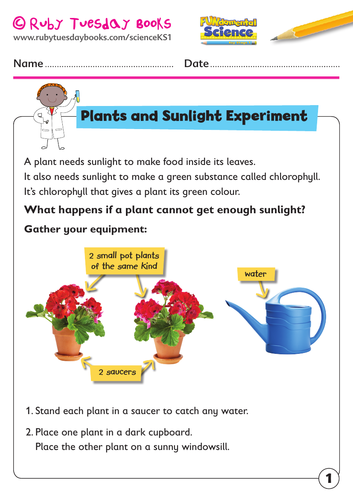
KS1 Science: Plants - plants and sunlight experiment.
Subject: Primary science
Age range: 5-7
Resource type: Worksheet/Activity
Last updated
24 January 2019
- Share through email
- Share through twitter
- Share through linkedin
- Share through facebook
- Share through pinterest

Observe the effect of limiting sunlight for plants. Quality scientific questioning to engage in intrigued children and scaffold learning. It complements our book ‘Roots, stems, leaves and flowers’ from our FUNdamental Science series. For more information, downloads and to purchase our books, please visit www.rubytuesdaybooks.com
This download helps meet the following National Curriculum targets:
Year 2 Science: Plants Statutory requirements: Find out and describe how plants need water, light and a suitable temperature to grow and stay healthy. Notes and guidance (non-statutory): Pupils might work scientifically by: observing and recording, with some accuracy, the growth of a variety of plants as they change over time from a seed or bulb, or observing similar plants at different stages of growth; setting up a comparative test to show that plants need light and water to stay healthy.
Year 1 Science: Plants Statutory requirements: Identify and describe the basic structure of a variety of common flowering plants, including trees. Notes and guidance (non-statutory): Pupils should use the local environment throughout the year to explore and answer questions about plants growing in their habitat. Where possible, they should observe growth of flowers and vegetables that they have planted. Pupils might keep records of how plants have changed over time, for example the leaves falling off trees and buds opening; and compare and contrast what they have found out about different plants.
Creative Commons "NoDerivatives"
Your rating is required to reflect your happiness.
It's good to leave some feedback.
Something went wrong, please try again later.
TES Resource Team
We are pleased to let you know that your resource KS1 Science: Plants - plants and sunlight experiment, has been hand-picked by the Tes resources content team to be featured in https://www.tes.com/teaching-resources/blog/fun-science-experiments in June 2024 on https://www.tes.com/teaching-resources/blog. Congratulations on your resource being chosen and thank you for your ongoing contributions to the Tes Resources marketplace.
Empty reply does not make any sense for the end user
Worked well for what I needed
Report this resource to let us know if it violates our terms and conditions. Our customer service team will review your report and will be in touch.
Not quite what you were looking for? Search by keyword to find the right resource:

Experiment to show that sunlight is essential for photosynthesis.
Experiment to prove that sunlight is essential for photosynthesis: procedure: step 1: keeping the plant in the darkroom: at first, we need to place a healthy green potted plant in a dark room for 1-2 days. this is done to ensure that the plant consumes all its reserve food and the leaves do not contain any starch. step 2: covering a specific part of a leaf: a part of the leaf is covered on both sides with two uniform pieces of black paper, fixed in position with two paper clips on both sides so that the leaf region below the black paper is not exposed to sunlight. step 3: exposing the plant to sunlight: now the plant is exposed to bright sunlight with the specific part of the leaf staying covered. step 4: decolorizing the leaf: after a few hours the specific leaf with the covering is removed. the black papers are removed and then the leaf is subjected to decolorization using alcohol in boiling water. the decolorization occurs as the chlorophyll is removed from the leaf and hence the leaf loses its pigmentation. step 5: adding iodine solution: to the decolorized leaf, iodine solution is added. observation: after adding the iodine solution the part of the leaf that was covered by black paper remains colorless while the region that was exposed to sunlight will have blue-black color. inference: the food prepared by plants (carbohydrates) through the process of photosynthesis is stored as starch. this starch reacts with the iodine solution to change to a blue-black color. only those portions of the leaf that were exposed to sunlight could photosynthesize and hence, change to a blue-black color when tested with iodine. the region that was closed by black papers on both sides were not able to photosynthesize and hence the color did not appear. this proves the importance of sunlight in the process of photosynthesis as it does not occur in the parts of leaves that are not exposed to sunlight..

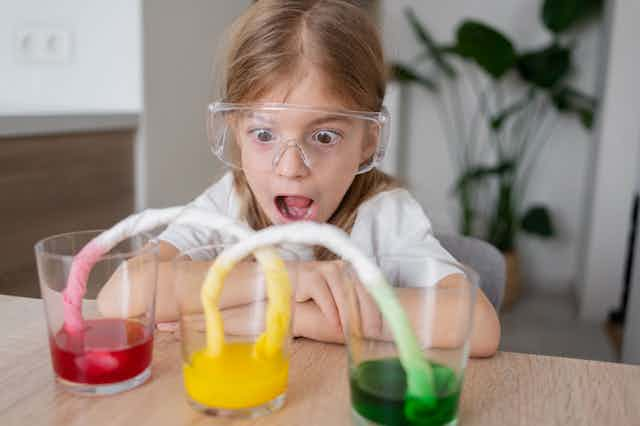
Summer holiday science: turn your home into a lab with these three easy experiments
Associate Professor in Biology, University of Limerick
Disclosure statement
Audrey O'Grady receives funding from Science Foundation Ireland. She is affiliated with Department of Biological Sciences, University of Limerick.
University of Limerick provides funding as a member of The Conversation UK.
View all partners
Many people think science is difficult and needs special equipment, but that’s not true.
Science can be explored at home using everyday materials. Everyone, especially children, naturally ask questions about the world around them, and science offers a structured way to find answers.
Misconceptions about the difficulty of science often stem from a lack of exposure to its fun and engaging side. Science can be as simple as observing nature, mixing ingredients or exploring the properties of objects. It’s not just for experts in white coats, but for everyone.
Don’t take my word for it. Below are three experiments that can be done at home with children who are primary school age and older.
Extract DNA from bananas
DNA is all the genetic information inside cells. Every living thing has DNA, including bananas.
Did you know you can extract DNA from banana cells?
What you need: ¼ ripe banana, Ziploc bag, salt, water, washing-up liquid, rubbing alcohol (from a pharmacy), coffee filter paper, stirrer.
What you do:
Place a pinch of salt into about 20ml of water in a cup.
Add the salty water to the Ziploc bag with a quarter of a banana and mash the banana up with the salty water inside the bag, using your hands. Mashing the banana separates out the banana cells. The salty water helps clump the DNA together.
Once the banana is mashed up well, pour the banana and salty water into a coffee filter (you can lay the filter in the cup you used to make the salty water). Filtering removes the big clumps of banana cells.
Once a few ml have filtered out, add a drop of washing-up liquid and swirl gently. Washing-up liquid breaks down the fats in the cell membranes which makes the DNA separate from the other parts of the cell.
Slowly add some rubbing alcohol (about 10ml) to the filtered solution. DNA is insoluble in alcohol, therefore the DNA will clump together away from the alcohol and float, making it easy to see.
DNA will start to precipitate out looking slightly cloudy and stringy. What you’re seeing is thousands of DNA strands – the strands are too small to be seen even with a normal microscope. Scientists use powerful equipment to see individual strands.
Learn how plants ‘drink’ water
What you need: celery stalks (with their leaves), glass or clear cup, water, food dye, camera.
- Fill the glass ¾ full with water and add 10 drops of food dye.
- Place a celery stalk into the glass of coloured water. Take a photograph of the celery.
- For two to three days, photograph the celery at the same time every day. Make sure you take a photograph at the very start of the experiment.
What happens and why?
All plants, such as celery, have vertical tubes that act like a transport system. These narrow tubes draw up water using a phenomenon known as capillarity.
Imagine you have a thin straw and you dip it into a glass of water. Have you ever noticed how the water climbs up the straw a little bit, even though you didn’t suck on it? This is because of capillarity.
In plants, capillarity helps move water from the roots to the leaves. Plants have tiny tubes inside them, like thin straws, called capillaries. The water sticks to the sides of these tubes and climbs up. In your experiment, you will see the food dye in the water make its way to the leaves.
Build a balloon-powered racecar
What you need: tape, scissors, two skewers, cardboard, four bottle caps, one straw, one balloon.
- Cut the cardboard to about 10cm long and 5cm wide. This will form the base of your car.
- Make holes in the centre of four bottle caps. These are your wheels.
- To make the axles insert the wooden skewers through the holes in the cap. You will need to cut the skewers to fit the width of the cardboard base, but leave room for the wheels.
- Secure the wheels to the skewers with tape.
- Attach the axles to the underside of the car base with tape, ensuring the wheels can spin freely.
- Insert a straw into the opening of a balloon and secure it with tape, ensuring there are no air leaks.
- Attach the other end of the straw to the top of the car base, positioning it so the balloon can inflate and deflate towards the back of the car. Secure the straw with tape.
- Inflate the balloon through the straw, pinch the straw to hold the air, place the car on a flat surface, then release the straw.
The inflated balloon stores potential energy when blown up. When the air is released, Newton’s third law of motion kicks into gear: for every action, there is an equal and opposite reaction.
As the air rushes out of the balloon (action), it pushes the car in the opposite direction (reaction). The escaping air propels the car forward, making it move across the surface.
- Science experiments

Head of Evidence to Action

Supply Chain - Assistant/Associate Professor (Tenure-Track)

Education Research Fellow

OzGrav Postdoctoral Research Fellow

Casual Facilitator: GERRIC Student Programs - Arts, Design and Architecture
share this!
August 23, 2024
This article has been reviewed according to Science X's editorial process and policies . Editors have highlighted the following attributes while ensuring the content's credibility:
fact-checked
peer-reviewed publication
trusted source
Innovative field experiments shed light on biological clocks in nature
by John Innes Centre
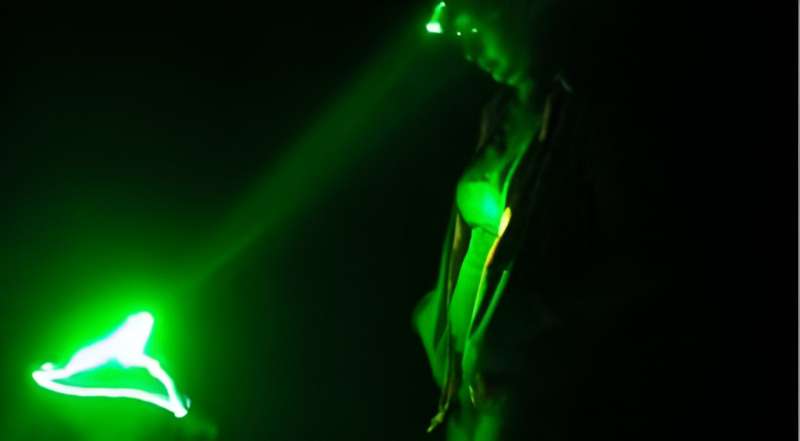
Much of what we know about plant circadian rhythms is the result of laboratory experiments where inputs such as light and temperature can be tightly controlled.
Less is known about how these biological timing mechanisms operate in the more unpredictable natural world where they evolved to align living things to daily and seasonal cycles.
A pioneering collaborative study between UK and Japanese researchers has helped redress the balance with a series of innovative field experiments that show how plants combine clock signals with environmental cues under naturally fluctuating conditions.
This research team from the John Innes Center, Kyoto University, and The Sainsbury Laboratory, Cambridge, have produced statistical models based on these field-based studies that could help us predict how plants, major crops among them, might respond to future temperatures.
"Our research highlights the value of international collaboration in cross-disciplinary scientific progress," said senior author Professor Antony Dodd, a group leader at the John Innes Center. "It is fascinating to see how processes we have identified in the lab also work to influence plants under natural conditions."
Professor Hiroshi Kudoh from Kyoto University said, "Any living system has evolved in the context of its natural habitat. A great deal of work lies ahead to assess the function of genetic systems under natural conditions. This study was designed as one of the beginnings of such an endeavor."
A previous study by the group of Professor Dodd identified a genetic pathway under the control of the biological clock that operates to protect photosynthesizing plants from cell damage in bright cold conditions.
In this present study, "Circadian and environmental signal integration in a natural population of Arabidopsis," which appears in PNAS , the research team set out to identify this same mechanism in nature, drawing on a strong body of "in natura" research led by Professor Hiroshi Kudoh.
In two field studies around the March and September equinoxes, they analyzed a natural population of Arabidopsis halleri plants on a rural Japanese field site.
They monitored how gene expression in the plants changed over 24-hour cycles as light and temperature varied.
Experiments involved extracting RNA from plants every two hours, freezing these samples and taking them back to the lab for analysis so that they could track gene expression levels in tissues.
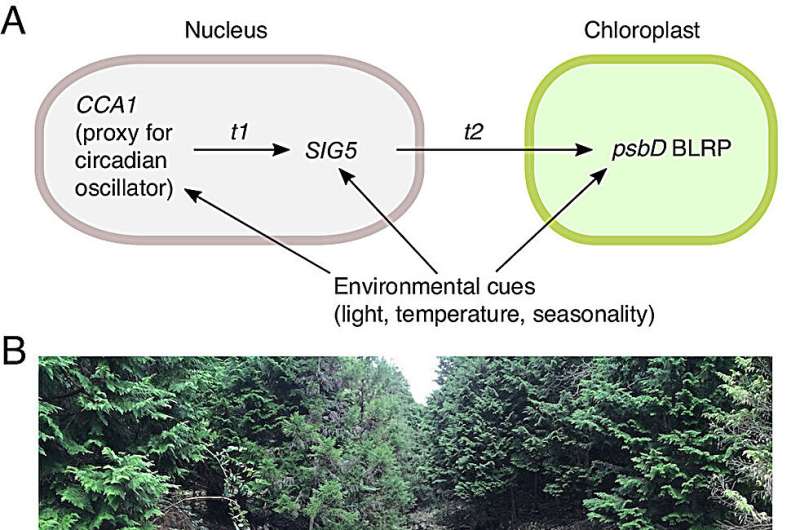
The team also built equipment that enabled them to manipulate the temperatures around plants. This enabled them to recapitulate the conditions they produced in the lab in their previous study.
Plants are highly sensitive to red and blue light; so, to avoid influencing experimental findings, researchers wore green filters over their head torches which effectively meant that they were invisible to plants during nocturnal visits.
"It is surprising how difficult it is to identify green plants with a green head torch in the middle of the night, in pouring rain," remarked Professor Dodd.
Using the information collected from samples, the researchers observed patterns in the expression of genes in the previously discovered genetic pathway that integrates information from the plant circadian clock with light and temperature signals.
The data collected showed that the plants in wild populations showed the same sensitivity to cold and bright dawn conditions previously observed in laboratory experiments.
Based on this information, the team developed statistical models which accurately predict how gene expression activity under control of the circadian clock will respond to environmental signals over a day in nature.
"We believe this is the first time anyone has modeled a whole circadian clock signaling pathway in plants growing outdoors," said Professor Dodd.
"If we can produce models that can accurately predict gene expression in relation to environmental conditions, then it may be possible to breed plants that are able to adapt to future climate conditions."
Dr. Haruki Nishio from Shiga University, joint first author on the study, said, "The flexibility of Bayesian time-series modeling allowed us to disentangle complex signal integration in natural environments. This approach has proven particularly effective for studies conducted in intricate environmental settings."
This study examined plant responses at the level of gene expression. The next stage for this research is to apply the statistical models produced in this study to functions of plant physiology such as the rate of photosynthesis or adaptation to temperature.
Dr. Dora Cano-Ramirez, a circadian clock researcher now at the Sainsbury Laboratory Cambridge University and joint first author of the research, said, "The circadian clock regulates many key plant processes as shown in studies under laboratory settings. However, we have not known the extent to which these processes translate to field conditions until now."
"Understanding how circadian-regulated processes are aligned with a fluctuating environment by modeling this signaling pathway, could be useful in predicting plant responses in an increasingly unpredictable climate."
Journal information: Proceedings of the National Academy of Sciences
Provided by John Innes Centre
Explore further
Feedback to editors

Saturday Citations: Tarantulas and their homies; how mosquitoes find you; black holes not mysterious at all
3 hours ago

Test of a prototype quantum internet runs under New York City for half a month

Researchers discover dual epicenters in New Year's Day Noto earthquake
18 hours ago

Carbon emissions from forest soil will likely grow with rising temperatures

Unconventional interface superconductor could benefit quantum computing
20 hours ago

Coaxing purple bacteria into becoming bioplastic factories
21 hours ago

NASA's DART impact permanently changed the shape and orbit of asteroid moon, new study shows
22 hours ago

New varactor enhances quantum dot device measurements at millikelvin temperatures

Aoudad and bighorn sheep share respiratory pathogens, research team discovers

Ecosystems study finds the higher the environmental stress, the lower the resistance to global change
Relevant physicsforums posts, homo naledi: 5 yr update & new findings (2021).
Aug 21, 2024
Hiking Illness Danger -- Rhabdomyolysis
Aug 18, 2024
Toxic Chemicals Found on old books
Strategies and tips for first responders interacting with autism spectrum disorder patients.
Aug 16, 2024
Cannot find a comfortable side-sleeping position
Using capsaicin to get really high.
More from Biology and Medical
Related Stories

How plants cope with the cold light of day, and why it matters for future crops
Mar 30, 2023

How plants become good neighbors in times of stress
Jun 29, 2021

Researchers discover optimum twilight time for plant growth
Aug 6, 2024

Altering the circadian clock adapts barley to short growing seasons
Feb 23, 2024

Plants can tell the time using sugars
Aug 2, 2018

Small protein that synchronizes the circadian clocks in shoots and roots
Apr 13, 2020
Recommended for you

Single nucleosomes tracked in live cells during cell division using super-resolution microscopy
23 hours ago

New approach for profiling complex dynamics at the single-molecule level

Research unravels dual role of membrane protein in rice ethylene signal transduction

Micro- and nanoplastics ingested by Drosophila cause changes in heart size and function
Aug 23, 2024

Scientists discover novel receptor recognition mechanism for alphavirus
Let us know if there is a problem with our content.
Use this form if you have come across a typo, inaccuracy or would like to send an edit request for the content on this page. For general inquiries, please use our contact form . For general feedback, use the public comments section below (please adhere to guidelines ).
Please select the most appropriate category to facilitate processing of your request
Thank you for taking time to provide your feedback to the editors.
Your feedback is important to us. However, we do not guarantee individual replies due to the high volume of messages.
E-mail the story
Your email address is used only to let the recipient know who sent the email. Neither your address nor the recipient's address will be used for any other purpose. The information you enter will appear in your e-mail message and is not retained by Phys.org in any form.
Newsletter sign up
Get weekly and/or daily updates delivered to your inbox. You can unsubscribe at any time and we'll never share your details to third parties.
More information Privacy policy
Donate and enjoy an ad-free experience
We keep our content available to everyone. Consider supporting Science X's mission by getting a premium account.
E-mail newsletter
August 20, 2024
I Bought a Glowing Plant. It Led Me Down a Rabbit Hole
A bioluminescent petunia led me to a world of radiant mushrooms, 19th century experiments and a modern rivalry between scientists in Russia and the Americas
By Rachel Ehrenberg & Knowable Magazine
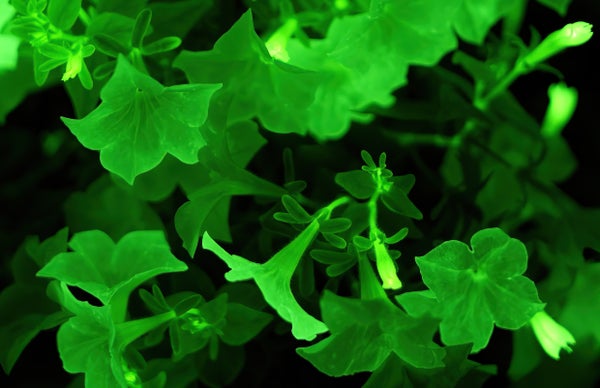
Firefly petunias ( detail ) engineered to glow continuously by the biotech start-up Light Bio.
Light Bio, Inc.
Petunias have never done much for me. If you had told me that one day, I’d fork over more than $50 for a single petunia plant, my eyes would have rolled out of my head. But this plant was special. This petunia glowed in the dark.
My plant was one of 50,000 shipped around the United States in April by the Idaho-based biotech start-up Light Bio . Called the “Firefly” petunia, it contains genes from bioluminescent mushrooms that make it constantly glow. A news release announcing the petunia’s arrival included a photo of a woman gazing serenely at a mass of flowers lit up like oversized glow-in-the-dark stars.
Well, that’s a neat trick, I thought.
On supporting science journalism
If you're enjoying this article, consider supporting our award-winning journalism by subscribing . By purchasing a subscription you are helping to ensure the future of impactful stories about the discoveries and ideas shaping our world today.
I also wondered whether the Firefly petunia was more than just a trick. Though it seemed inconsequential, perhaps there was some implication I hadn’t thought of. At the very least, the plant might make me — a great admirer of plants (but a bit of a botanical snob) — think differently about petunias, those go-to ornamentals for gas stations and mansions alike.
I decided to learn more. So I paid my $53 ($29 for the plant, $24 for shipping) and placed an order.
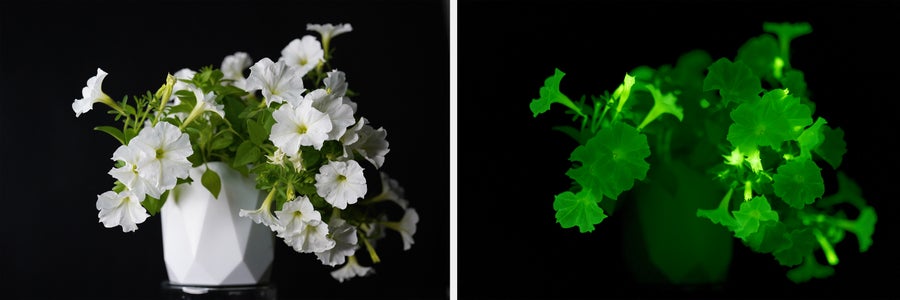
The Firefly petunia’s flower buds seem to give off the most light, as seen with the specimen shown in both daylight and in the dark.
Light Bio. Inc.
Behold, bioluminescence
Bioluminescence is the emission of light by living things. It is generated by a chemical reaction within the organism (unlike the phosphorescence of glow-in-the-dark stickers, which need to be charged up with light before emitting it). Bioluminescence is widespread, especially in the oceans : There are bacteria, sea snails, shrimp, fish and squid that glow. Terrestrial glowers include some insects and worms as well as fungi.
Scientists have worked out the precise chemical compounds involved for only a handful of bioluminescent organisms. But for the most part, the basics of the light-producing reaction are the same: It requires fuel, oxygen and a catalyst to get the reaction going. In the parlance of bioluminescence research, the fuel is called the luciferin and the catalyst is called the luciferase. The luciferase helps to add oxygen to the fuel, transforming it into a very reactive, high-energy compound. As this overexcited luciferin relaxes, it emits light.
This ability to produce light has been documented in hundreds of genera across the tree of life. Scientists think it evolved independently in various lineages , perhaps more than 94 different times.
Organisms use bioluminescence in a variety of ways. For fireflies, it’s a come-hither signal that attracts mates. Some fish use it to lure prey. Other animals, such as the vampire squid, which can expel a cloud of glowing mucus, use it to distract or confuse predators. In many lineages, giving off light may have arisen as a detoxification strategy . When oxygen is in a reactive state, it can ricochet through cells and damage molecules. This suggests that many luciferins were antioxidants first; their primary role was to mop up damaging oxygen that had been generated during metabolism.
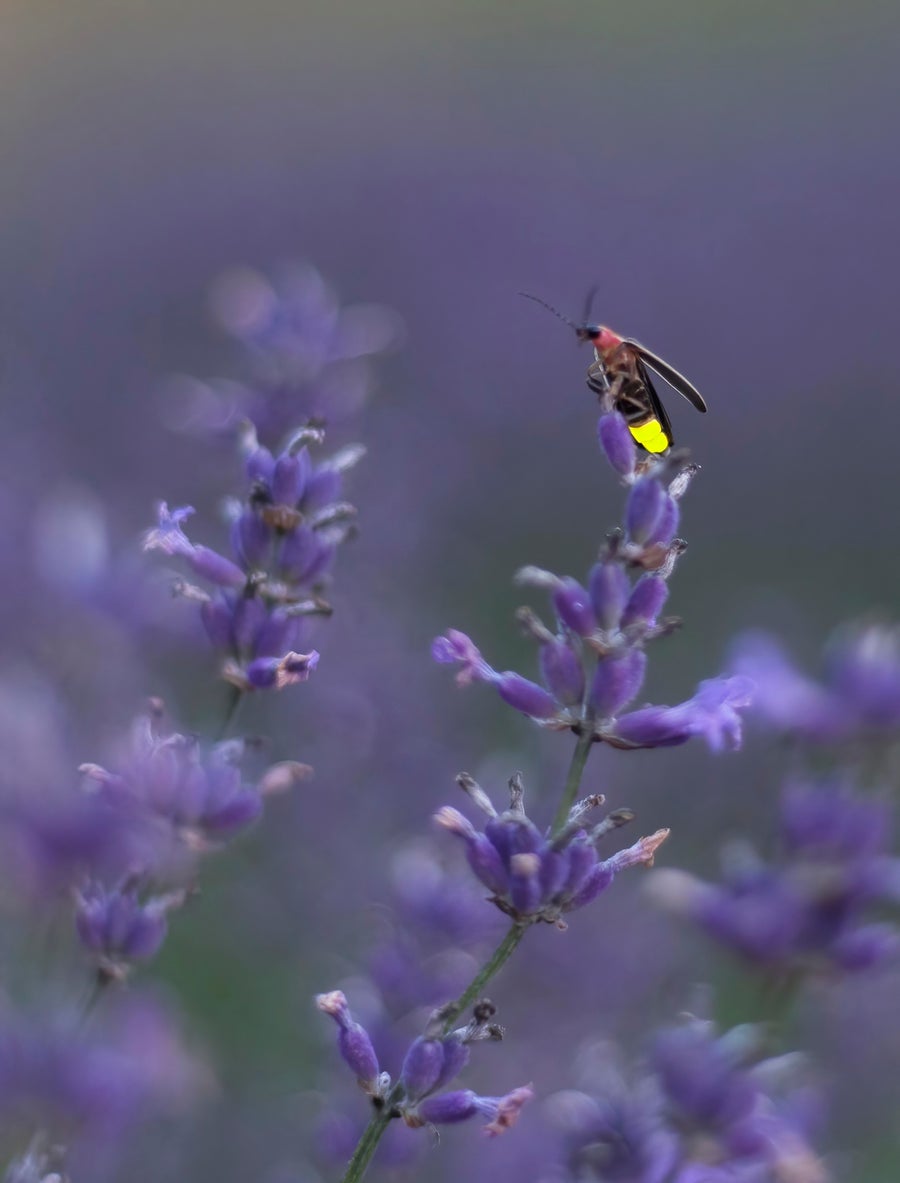
Fireflies are perhaps the most recognized bioluminescent organisms, but the ability to emit light has been documented in hundreds of genera across the tree of life and has evolved multiple times in multiple lineages.
Kim Hadley Photography/iNaturalist ( CC BY-SA 4.0 )
Hunting for the fungal glow
Bioluminescent fungi have long grabbed people’s attention. In the fourth century BCE, Aristotle noted that fungi could be “fiery and glittering” in the dark. A few centuries later, Pliny the Elder , in his encyclopedic Natural History , mentions the “ brilliant light ” emitted by a mushroom that grows on trees. But until recently, no one knew exactly what fungi were using as the fuel or catalyst, or even whether all glowing fungi light up in the same way.
The hunt for fuel and catalyst molecules culminated in 2017 after more than a century of research and a yearslong international race between a scrappy team from the Americas and a well-connected lab in Russia. Yet even before then, scientists had been trying to unravel the mysteries of bioluminescence.
In the 1880s, French physiologist Raphaël Dubois was investigating a click beetle of the genus Pyrophorus , among the brightest of bioluminescent insects. Dubois ground up the glowing parts of the beetle in cold water. They glowed and then faded to nothing. Then he did the same in boiling water: no glow. But when he added the hot mixture to the cold, the mixture glowed. Dubois (who would go on to coin the terms luciferin and luciferase ) realized that the reaction required a catalyst and fuel. Only the cold water contained working catalyst — boiling destroyed it. But both hot and cold extracts contained the fuel, which survived boiling. Adding the hot extract to the cold extract provided fresh fuel to the extract with functioning catalyst — and so it generated light.
Decades later, scientists would conduct this hot/cold experiment with bioluminescent fungi, but the identity of the fuel and the catalyst still eluded them.
Roughly 130 fungus species are bioluminescent, says mycologist Dennis Desjardin , emeritus researcher at San Francisco State University, who has described several of those species. Fungi spend most of their lives as webs of thread-like filaments called mycelia, and the mycelia of the bioluminescent fungi give off light, though it’s often hidden within the decaying wood in which many of them grow. In species that bear mushrooms, the mushrooms may glow too.
In 2005, Desjardin began working with chemist Cassius Stevani of the University of Sao Paulo, Brazil, who was looking into how fungi generated their glow. Stevani, along with then-graduate student Anderson Oliveira , had refined Dubois’ hot/cold experiment, adding various cellular chemicals to grease the reaction. After perfecting the protocol, Stevani wanted to perform the hot/cold experiment using different species of fungi, one species for the cold and another species for the hot. These cross-species experiments showed that the different fungi used the same catalyst and fuel , suggesting that bioluminescence had evolved just once in the fungal lineage, Stevani and Desjardin reported in 2012.
“This was very important,” says Stevani. “It was saying, Oh, if you have a fungus in Russia or in Asia, you can use it to study the mechanism, because it’s the same in all fungi.”
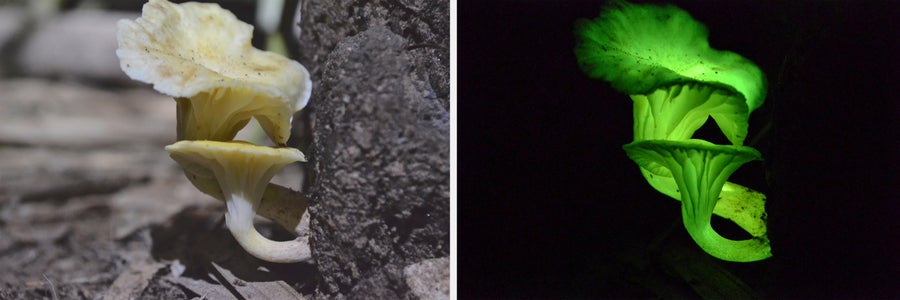
The bioluminescent fungus Neonothopanus gardneri from the state of Piauí in northeast Brazil, where the mushrooms grow on the base of babassu palms. Roughly 130 fungal species are bioluminescent.
Cassius Stevani/ IQ-USP, Brazil
Meanwhile, biochemist Ilia Yampolsky , who now heads a lab at the Russian Academy of Sciences in Moscow, was also hot on the fungal-light trail. Stevani got wind of this development. “I got crazy, of course, because, I was studying this for 15 years,” he says. He wrote to Yampolsky in 2015, suggesting that they collaborate. But the Russians had beaten Stevani to the luciferin punch; their discovery just hadn’t been published yet.
The fungal fuel turned out to be made from an antioxidant called hispidin. Hispidin is found not only in fungi, but also in many plants as well. “The molecule I was searching for, for 15 years — I look out of my window, I see plants that have this molecule,” Stevani says.
Since then, the two teams have collaborated. (“We colluded with the Russians,” Desjardin jokes.) They nailed down details of the biochemical assembly line that leads up to the light-emitting reaction and published the results together in the Proceedings of the National Academy of Sciences in 2018. Stevani got to name the fungal catalyst. He called it luz , the Portuguese word for light.
Out of fungi and into the petunia
A key discovery in the creation of the glowing petunia was the source of the luciferin fuel in the fungi. It’s made from a precursor compound called caffeic acid that is common in fungi and in plants. The fungal assembly line for making light forms a tidy loop — caffeic acid gets converted to hispidin, hispidin gets converted to the fuel, the fuel gives off light and the remaining compound gets converted back into caffeic acid — restarting the loop. Stevani realized that if plants also made that precursor compound, then practically any plant might be engineered to glow. He said as much to Yampolsky. “I said, ‘Man, we have a system that uses caffeic acid. We can transform any plant!’”
Yampolsky replied, “What do you think I am doing?”
Russian synthetic biologist Karen Sarkisyan led the careful work of sorting out the various genes involved in the light-emitting reaction. Then the team stuck those genes — from the bioluminescent fungus Neonothopanus nambi — into a tobacco plant. It worked: The shoots, buds, flowers and even roots — they all glowed . “Plants and fungi, they speak a similar biochemical language,” says Sarkisyan, a cofounder of Light Bio who now runs his own lab at Imperial College London. “And because they speak that similar biochemical language, it was relatively easy to translate the metabolic pathway from the fungus to the plant.”
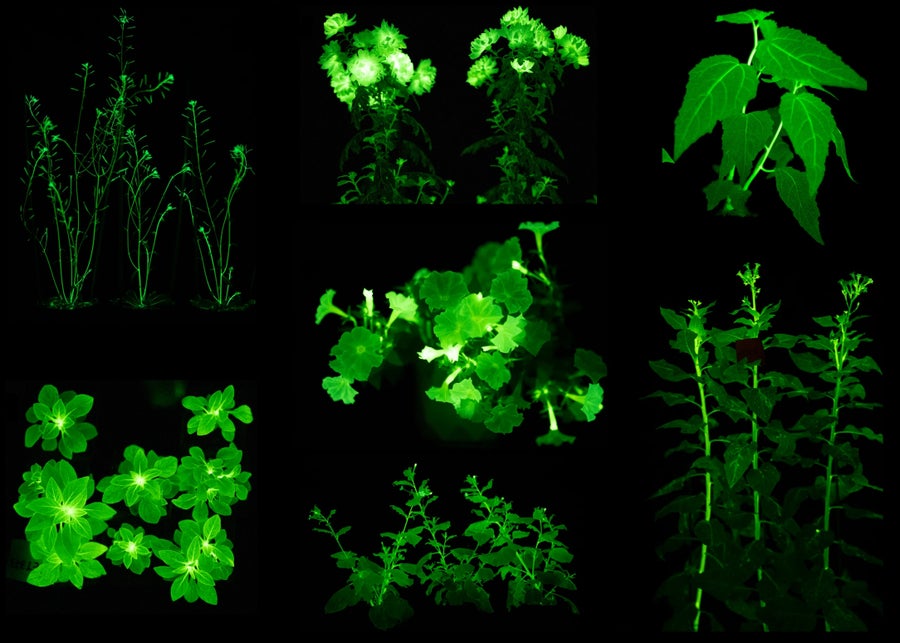
After some clever genetic tinkering, scientists successfully engineered several kinds of plants to glow using genes from fungi: the mouse-ear cress Arabidopsi thaliana ( top left ), a chrysanthemum ( top middle ), poplar ( top right ), petunia ( center and bottom left ), Nicotina benthamiana ( bottom middle ) and tobacco ( bottom right ).
"An improved pathway for autonomous bioluminescence imaging in eukaryotes," by Shakhova, E.S., Karataeva, T.A., Markina, N.M. et al., in Nature Methods , Published online January 22, 2024
With a bit more genetic tinkering, Sarkisyan, Yampolsky and their collaborators managed to coax other plants — chrysanthemum, poplar, Arabidopsis and petunia — into glowing. By September 2023, the US Department of Agriculture had approved Light Bio’s request to make and sell glowing petunias , determining that the plants posed no great risks. Five months later, I placed my order.
Oh, Petunia
My petunia looked like an ordinary white garden petunia when it arrived. It was a bit disheveled; I transplanted it into a new pot and gave it some water and a spot by a sunny window. After a few weeks it perked up. When I brought it into a dark closet, its flowers faintly glowed — dimmer than a candle, but glowing nonetheless.
I had intended to look into whether the petunia could wreak any ecological havoc — what if it interbred with wild species and the glowing genes escaped? Might our outdoor spaces be transformed into (very quiet) botanical raves? But the petunia’s light seemed too dim to interfere with much of anything.
Elsa Youngsteadt , who coauthored an article in the 2023 Annual Review of Ecology, Evolution, and Systematics on how constant light in urban environments may influence pollination, basically agreed with me.
She explained that there aren’t any wild native petunias in the United States, which is the only place where the Firefly petunia is currently available. The ubiquitous common garden petunias are all hybrids, the result of a long history of crossing the white-flowered and moth-pollinated Petunia axillaris with a pigmented, bee-pollinated species . These hybrid petunias already present a crazy mix of signals that might confuse a pollinator, says Youngsteadt, a pollination ecology expert at North Carolina State University. And none of them have proved to be invasive in the United States.
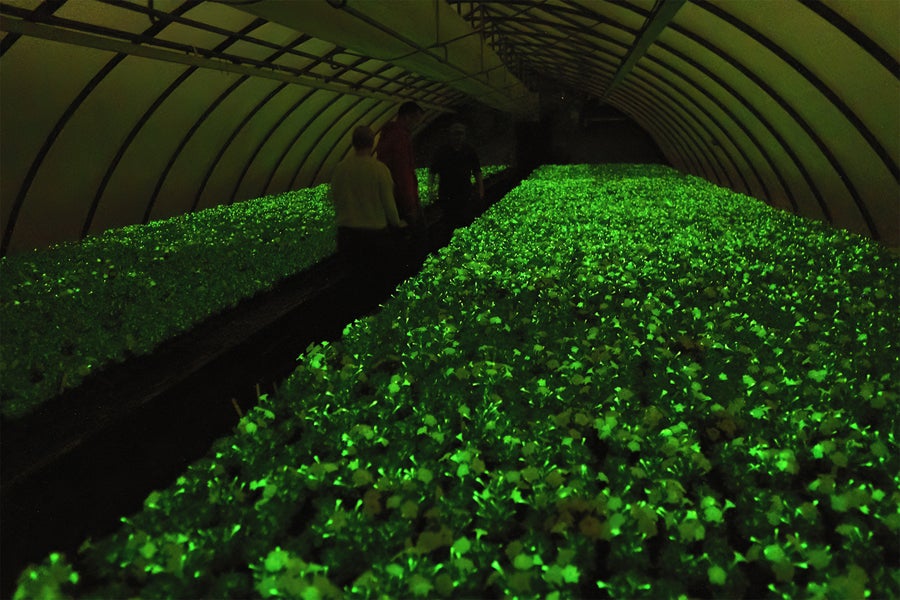
A greenhouse filled with Firefly petunias.
So — the Firefly petunia? “I’m not immediately alarmed by it,” Youngsteadt says. But, she adds, “Why would we put time, money and potential risk into making something glow for fun?”
Why indeed. In fact, the more I thought about it, the more I wondered whether popping the fungal genes into the petunia was just the whimsical icing on a cake. The cake — the real marvel — was all the years of gumshoe detective work that went into figuring out precisely how the fungi got their glow. And that made me look at my petunia with a fondness that surprised me.
This article originally appeared in Knowable Magazine , an independent journalistic endeavor from Annual Reviews. Sign up for the newsletter .
- Environment
UF space biologist to conduct experiment Thursday on Blue Origin New Shepard rocket
How do plants adapt when they go into space?
That’s the question the University of Florida Institute of Food and Agricultural Sciences (UF/IFAS) hopes to answer with a novel space-based experiment happening Thursday morning when a UF/IFAS horticultural sciences researcher launches with his experiment into suborbital space on a Blue Origin New Shepard rocket.
Rob Ferl, the University of Florida Astraeus Space Institute director, will fly in the Blue Origin craft at 9 a.m. Thursday and perform the experiment himself. The experiment builds on prior research that showed a type of plant — Arabidopsis thaliana — can detect that it is in space and then change how its genes are expressed.
"This moment is a milestone not just for the University of Florida and the Astraeus Space Institute but for an entire community of scientists who can now consider experiments in space that might have previously been viewed as impossible," said UF Interim President Kent Fuchs. "I look forward to cheering Rob on during Thursday’s mission and to watching him make history yet again."
Beer in space: UF/IFAS researchers study microgravity’s effect on fermentation
This experiment will determine which genes turn on and off at various stages of flight. Although much is known about how plants respond to living in spaceflight environments, like the International Space Station, researchers know less about how plants respond molecularly as they travel to space. The experiment will provide new insights into how plants adjust their gene expression as they transition from Earth to space.
One day, plants might be an essential part of space exploration as food and air scrubbers, and understanding how they react to a space environment is the first step toward learning how to effectively grow them there.
“We envision plants will keep us alive in space or on the moon,” said Ferl, who is also assistant vice president for UF Research. “What does it take to adapt to living in space? We’d like to know.”
Anna-Lisa Paul, co-principal investigator for the experiment, a horticultural sciences research professor and director of UF’s Interdisciplinary Center for Biotechnology Research, said researchers have only been able to see what this plant’s genes are like before and after space flight, not during.
“It’s something outside the evolutionary environment of any terrestrial species,” she said. “This is something we’re learning that has never been done before.”
The research was funded by a grant from NASA’s Flight Opportunities program and the agency’s Biological and Physical Sciences division.
Ferl will carry the plants in specialized tubes, called Kennedy Space Center Fixation Tubes (KFTs), that have a plunger to release a preservative solution. The tubes will be Velcroed to the legs of his flight suit during the flight. Before and after the flight, they will be moved in custom transit bags designed by the UF Space Plants Lab out of blackout fabric and a golden thermal blanket.
The experiment has a second purpose: to validate that having researchers do their own experiments on flights is a valuable use of research funding, rather than relying on untended experiments or robotics. This is the first NASA-supported researcher-tended suborbital flight.
“There’s something to be said about first-hand experience,” Ferl said. “The experiment is enriched when a human mind and a human brain go with it.”
The study will look at the plant’s transcriptome, the collection of all expressed RNA that contains answers to which genes are turned on and off to change the plant to adapt in a space environment. Ferl will chemically “lock” the genes with a preservative solution to pause the plants at a moment in time during various points in the launch — just before takeoff, at the start of zero gravity, at the end of zero gravity and at landing.
Researchers will then sequence the plants’ expressed genes and compare them to an on-Earth control experiment to figure out exactly which ones were activated or deactivated during the flight.
Jordan Callaham, assistant director for the UF Astraeus Space Institute and research coordinator for the UF Space Plants Lab in the UF/IFAS department of horticultural sciences, said this will help researchers begin to understand how plants would respond on space missions, on the moon or on Mars. But it will also give them a better idea of the fundamental properties of the chemical pathways within plants and how they respond to all novel environments.
“We’re understanding how biology responds to space on a very basic level,” said Callaham, who will be doing the on-Earth control experiment while Ferl is on the Blue Origin rocket.

IMAGES
COMMENTS
The experiment definitely made an impression on then-four-year-old Emma. She spent weeks afterwards drawing plants in the sun, like this: The little animal on the top right is a bumblebee, pollinating the flowers =) More Plant Themed Learning Activities for Kids. Extend this simple science experiment with more plant themed learning:
Wrap the tops and sides of cartons 2-5 in aluminum foil to block light from reaching the plants. Don't cover the holes in the bottom. Write the number of the carton onto the aluminum foil with the permanent marker. Record the time and date that the seeds were planted in your lab notebook.
Procedure: Fill each pot with soil. Plant one bean seed in each pot. Make sure you gently cover each seed with a shallow layer of soil. Place three of the pots outside in a spot that receives lots of sunshine. If the weather is too stormy or overcast, position the pots under a grow light. Place the remaining three pots in a dark cupboard.
A scientist takes a question like this and then conducts an experiment to see what really happens and to gather data or facts. Today, we will start an experiment that will take a week to conduct, to see if plants need sunlight and to see what happens to plants when they don't get sunlight. Activity. Give each pair or small group of 3—4 ...
Easy photosynthesis experiment. Materials: Procedure: Place students in groups and pass out two cups of water, two fresh leaves, 2 small rocks, a hand lens, and a lab sheet. Students place a leaf in a clear cup of water. Then, they place the other leaf in the other cup of water. Put one of the cups in a sunny spot and one in a dark spot.
Prepare 0.2% baking soda solution. Dissolve 2 g baking soda into 1,000 mL of distilled water. The amount of baking soda solution that you will need depends on the number of teams and the type of cups that you provide for the investigation. The procedure asks students to pour solution into their cup to a depth of 2 cm.
Credits. Photo: Stuart Darsch. Plants rely on the energy in sunlight to produce the nutrients they need. But sometimes they absorb more energy than they can use, and that excess can damage critical proteins. To protect themselves, they convert the excess energy into heat and send it back out.
Light Experiments. Topic: plant science, environment. Time to Complete: 6-8 weeks. Grade Level: 3-5, 6-8. Location (s): Indoor. Season: Winter, Spring, Summer, Fall. Download Resource. Students will learn about how light is important to plants, and how both quality and quantity of light affect plant growth. Jump to:
In this experiment, we used some kitchen towel rolls to cover the beans so that they don't have sunlight. We made an opening on the top of the kitchen towel ...
A simple home experiment to show how sunlight affects the growth of a plant.Visit us at the following:Website: https://precioustime.com.myFacebook: t https:/...
The aim of this science experiment is to prove that plants need sunlight to grow. www.infobells.com
Sunlight plays a crucial role in plants' survival. Plants need energy from the sun to make food through the process of photosynthesis. Photosynthesis is the process within a plant that converts sunlight, oxygen, and water into food. Without sunlight, plants cannot produce their own food. This plant needs experiment is a great way to ...
ion that requires energy. The energy comes from the Sun in the form of sunlight. Water, which is needed for the reactio. to proceed, is transformed into oxygen gas (O2) as a product of photosynthesis. The overall process (figure. R2.1) can be visualized in terms of inputs, energy and organisms, an.
Experiment. This experiment tests what type of liquid is best for growing seeds and can be done using a wide variety of liquids. Since we already discussed that plants need water to grow, we first tested different types of water to see if it made a difference. We decided to test tap water, bottled water, sugar water (1 cup of water with 1 Tbsp ...
In this lesson, students investigate how plants need water and sunlight to grow. In the two-part activity, Seeds — Light and Dark, students experiment with growing radish seeds in light and dark conditions. They plant them in cups, place half of the cups in sunlight, and put the other half in a dark container.
Procedure: Begin with 12 small, healthy plants. Divide them into four groups. Label the pots with words or simple pictures, three pots each: sun, water, sun and water, nothing (neither sun nor water). Keep the "sun" plants in the sunny spot; keep the others in the dark place. Water the "water" plants daily or as necessary for your climate.
Apply the recommended dosage of fertilizer. Place a colored filter tent over each plant. One filter should be clear. Use blue, yellow, and red film for the other filters. Place the aquarium in direct sunlight. Keep in the same location during the experiment and water daily. Measure each plant every day and record your findings in a notebook.
Now that we know plants need sunlight, let's try another experiment to see the effect of hours of sunlight on plant growth. Experiment 2: From a bag of lima beans, select 20 large, almost identical beans, Take 4 plates and place 5 beans in each plate. Number the plates from 1 to 4. Pure some water in each place and cover them with cloth.
KS1 Science: Plants - plants and sunlight experiment. Subject: Primary science. Age range: 5-7. Resource type: Worksheet/Activity. File previews. pdf, 1.02 MB. Observe the effect of limiting sunlight for plants. Quality scientific questioning to engage in intrigued children and scaffold learning. It complements our book 'Roots, stems, leaves ...
Twinkl has created this beautifully-illustrated Effect of Sunlight on Plant Growth Experiment just for you. Use this worksheet to predict plant growth. It comes with simple to follow instructions, as well as space for your children to write their observations. This would be a great introduction to the Scientific Method. This is because it introduces the concepts of: Observation - Plants grow ...
Experiment to prove that sunlight is essential for photosynthesis: PROCEDURE: Step 1: Keeping the plant in the darkroom: At first, we need to place a healthy green potted plant in a dark room for 1-2 days. This is done to ensure that the plant consumes all its reserve food and the leaves do not contain any starch.
If the amount of sunlight is increased, then plant growth will increase. The hypothesis that plant growth increases as the amount of sunlight increases was supported by the data. Plant 3, which was placed in a cabinet, only grew 2 cm. Plant 2, which was in full sunlight, grew 12 cm. Study with Quizlet and memorize flashcards containing terms ...
The experiment showed that sunflowers "seem to wiggle." ... Peleg said the plants found a "sweet spot" where they moved just the right amount so that the group balanced sunlight and shade ...
Plants have tiny tubes inside them, like thin straws, called capillaries. The water sticks to the sides of these tubes and climbs up. In your experiment, you will see the food dye in the water ...
Experiments involved extracting RNA from plants every two hours, freezing these samples and taking them back to the lab for analysis so that they could track gene expression levels in tissues.
A new study has used a series of innovative field experiments to show how plants combine circadian clock signals with environmental cues under naturally fluctuating conditions.
Wonder what will happen to the plant if it was kept in the darkness? We tried this experiment and the plant turn into yellow. However, if you expose the yell...
Further experiments subjecting the anemones to different colours of light revealed that, just like sun-tracking plants, the anemones' movements are primarily influenced by blue light wavelengths ...
But this plant was special. This petunia glowed in the dark. My plant was one of 50,000 shipped around the United States in April by the Idaho-based biotech start-up Light Bio. Called the ...
The experiment builds on prior research that showed a type of plant — Arabidopsis thaliana — can detect that it is in space and then change how its genes are expressed.